Birds are a crucial part of Darwin’s rich and diverse wildlife landscape. The Northern Territory, where Darwin is located, boasts more than 400 species of birds, from the tiny Pardalote to the majestic Wedge-tailed Eagle.
The unique habitat of the Top End region, including a mixture of wetlands, mangroves, forests, and coastal areas, provides ideal conditions for birdlife to thrive.
Darwin is a popular destination for birdwatching enthusiasts from around the world, who come to witness the spectacular sight of birds in their natural habitat.
We’ll explore the different birds found in Darwin, their habitats, and behaviors, and the role they play in the unique ecology of the region.
1. Jacanas
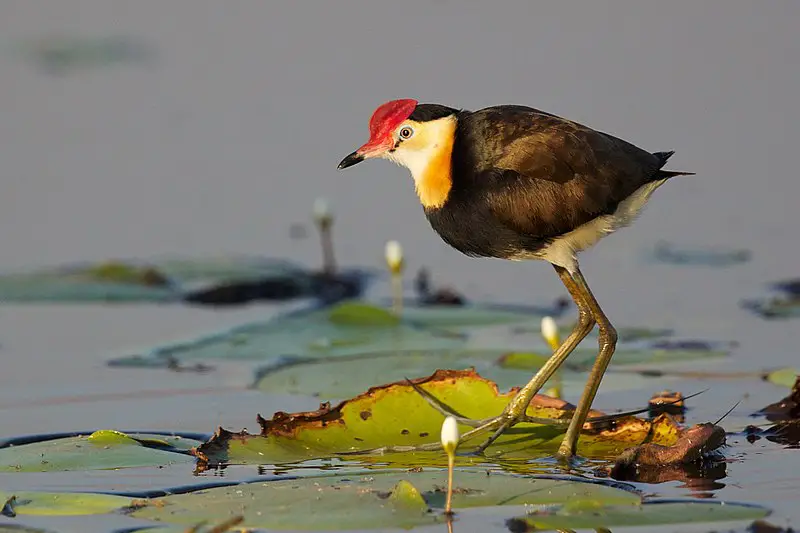
Jacanas are tropical waders belonging to the Jacanidae family. They have distinctive elongated toes and toenails which help them forage on floating or semi-emergent aquatic vegetation.
This adaptation gives them their nickname “Jesus birds” as they seem to be able to walk on water.
The female jacanas are also unique amongst bird species in that they take charge of nest building, incubation and caring for young while males perform courtship displays.
These unusual birds can be found throughout the world’s tropical regions where they inhabit wetlands such as swamps, marshes and shallow lakes with lily pads.
With a wide variety range due their special adaptations these beautiful creatures will surely continue living life at ease around our planet’s warmest waters.Scientific classification:
| Kingdom | Animalia |
| Phylum | Chordata |
| Class | Aves |
| Order | Charadriiformes |
| Suborder | Thinocori |
| Family | Jacanidae Stejneger, 1885 |
Also Featured In: Beautiful Brazilian Birds, Water Birds Live around Us
2. Brahminy Kite
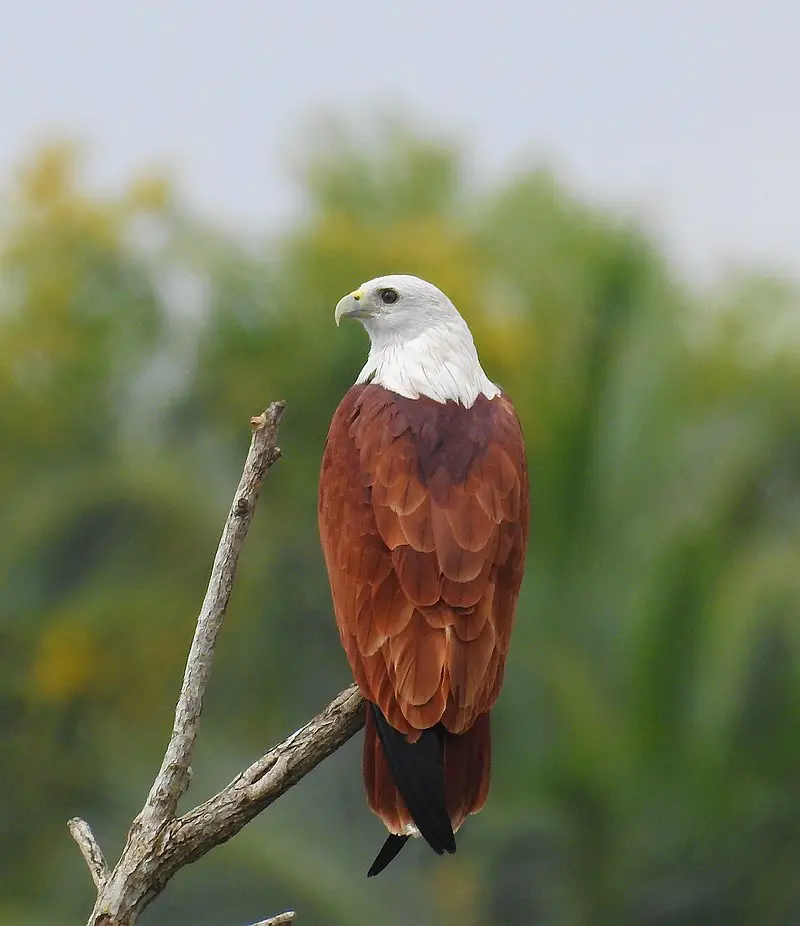
The Brahminy Kite is a majestic bird of prey native to the Indian subcontinent, Southeast Asia and Australia. It was formerly known as the red-backed sea eagle in Australia.
This medium-sized raptor has a distinctive white head with rufous brown feathers covering its body, making it easily recognisable from far away. The wingspan can reach up to 5 feet wide.
Brahminy kites are found mainly on coasts and inland wetlands where they feed mostly on dead fish or carrion left by other animals.
They also hunt for small mammals such as rodents or reptiles like lizards and snakes during dry spells when food sources become scarce.
These birds have adapted well over time and will even scavenge for food near picnic sites or urban areas if need be.
Overall these beautiful creatures are an important part of their local ecosystems which rely heavily upon them for keeping animal populations balanced through natural predation methods instead of manmade ones; this ensures that nature remains healthy so future generations may enjoy it too.Scientific classification:
| Kingdom | Animalia |
| Phylum | Chordata |
| Class | Aves |
| Order | Accipitriformes |
| Family | Accipitridae |
| Genus | Haliastur |
| Species | H. indus |
Also Featured In: Most Common Types of Bangladeshi Birds, Birds of Goa
3. Frogmouth
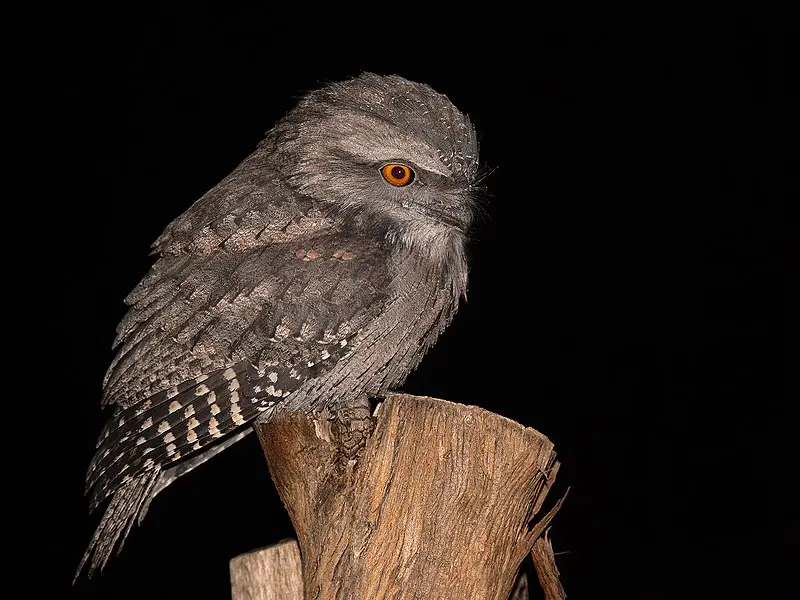
The Frogmouth is a nocturnal bird that belongs to the same family as owlet-nightjars, swifts and hummingbirds.
They have large flattened hooked bills with huge frog-like gape which helps them capture insects during night time.
Three species of Podargus are found in Australia and New Guinea only – they have massive eyes that allow for excellent night vision.
Their bodies are generally grey or brownish in colour with cryptic markings for camouflage when roosting during day light hours.
Generally known as quiet birds, their loud wailing call can be heard at dusk or dawn near river banks or wetlands where they live alone or form pairs throughout breeding season.
The diet of these fascinating creatures consists mainly of flying insects such as moths, beetles & cicadas etc., but on occasion will consume small vertebrates like lizards and frogs too.Scientific classification:
| Kingdom | Animalia |
| Phylum | Chordata |
| Class | Aves |
| Clade | Strisores |
| Order | Podargiformes Matthews, 1918 |
| Family | Podargidae Gray, 1847 |
Also Featured In: Birds of the Philippines, Asian Birds
4. Pacific Reef Heron
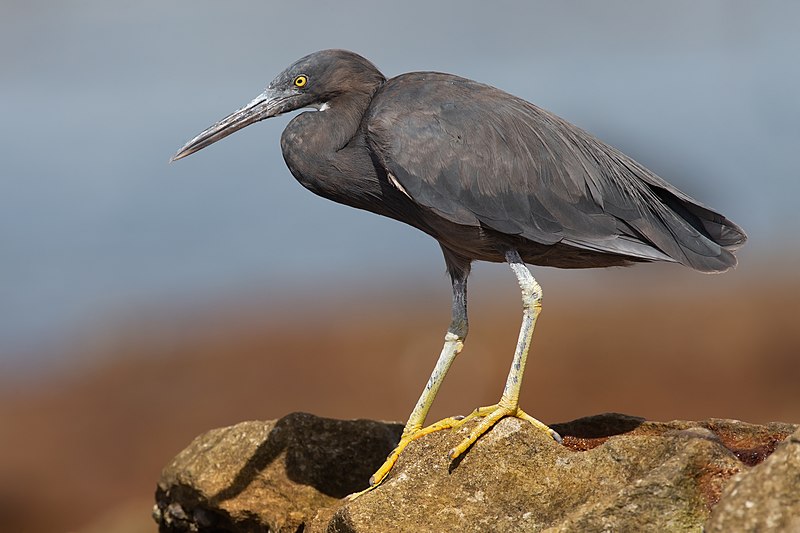
The Pacific reef heron is a species of heron found throughout Southern Asia and Oceania. It has two distinct colour morphs, one with slaty grey plumage and the other fully white.
This bird is easily identifiable by its long legs and yellow bill which are used to forage in shallow water bodies.
The sexes look alike except for minor differences such as size or body shape.
They feed on small fish, amphibians, crustaceans and molluscs that they find near reefs or mangroves where they roost during day time hours often preening their feathers if disturbed by predators like hawks or eagles .
When breeding season arrives these birds become more vocal using loud honking calls to attract mates before settling down into nests built among trees around wetlands or coastal areas.Scientific classification:
| Kingdom | Animalia |
| Phylum | Chordata |
| Class | Aves |
| Order | Pelecaniformes |
| Family | Ardeidae |
| Genus | Egretta |
| Species | E. sacra |
Also Featured In: Common Republic of Nauru Birds, Birds of Hyōgo
5. Honeyeaters
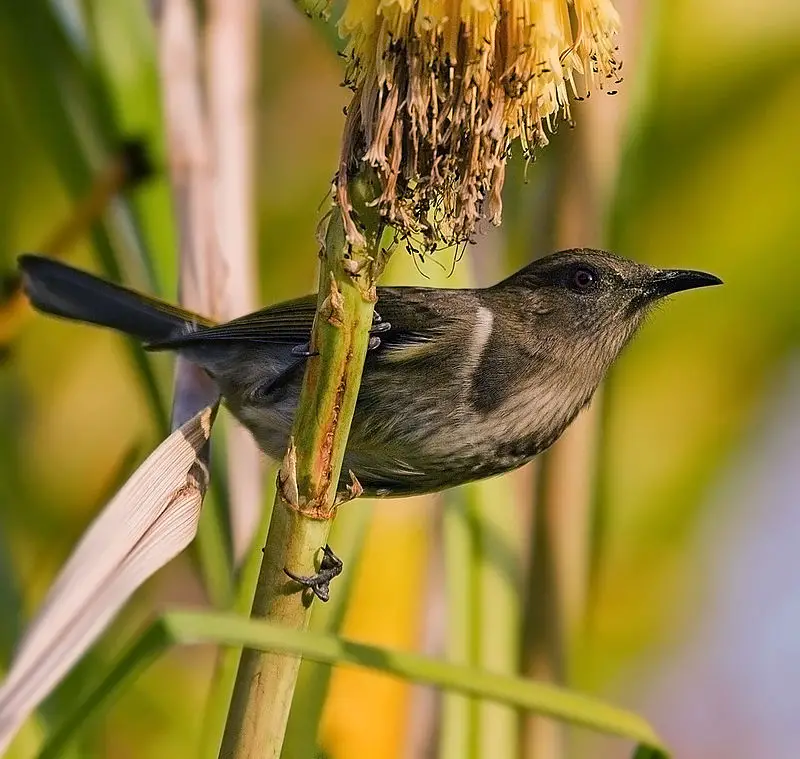
Honeyeaters are a unique and diverse family of birds, with species ranging in size from small to medium.
Found mainly in Australia and New Guinea, they can also be found as far east as Samoa and Tonga, or on islands such as Wallacea north or west of New Guinea.
Honeyeaters feed mainly on nectar but will consume insects if necessary for additional nutrition. They have specialized brush-like tongues that help them extract the nectar efficiently.
Their bright colours tend to make them stand out among other bird families making them easy to spot when out observing wildlife.Scientific classification:
| Kingdom | Animalia |
| Phylum | Chordata |
| Class | Aves |
| Order | Passeriformes |
| Superfamily | Meliphagoidea |
| Family | Meliphagidae Vigors, 1825 |
Also Featured In: Most common birds in Australia, Guam Birds You Need to See
6. Rainbow Bee-Eater
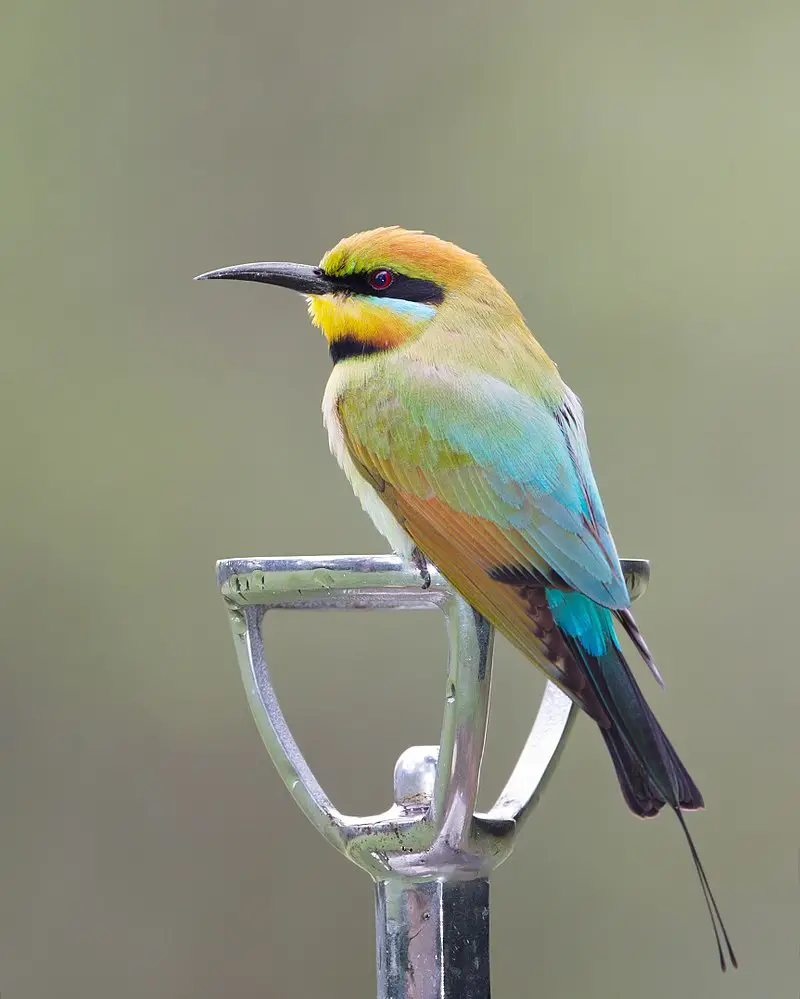
The Rainbow bee-eater (Merops ornatus) is a delightful near passerine bird belonging to the bee-eater family Meropidae.
It is found exclusively in Australia, making it one of only two species of its kind throughout the world; its closest relative being located in Southern and Eastern Africa – the olive bee-eater (Merops superciliosus).
Its stunning plumage features a unique palette of colours including shades pinkish reds, blues, greens and yellows which make for an impressive display when seen up close.
Due to their diet consisting mainly on bees and other insects they have adapted specialised beaks with serrated edges that allow them to easily capture their prey mid flight.
A truly remarkable sight indeed.Scientific classification:
| Kingdom | Animalia |
| Phylum | Chordata |
| Class | Aves |
| Order | Coraciiformes |
| Family | Meropidae |
| Genus | Merops |
| Species | M. ornatus |
Also Featured In: Queensland Birds You Should Know, Birds of Far North Queensland
7. Pheasant Coucal
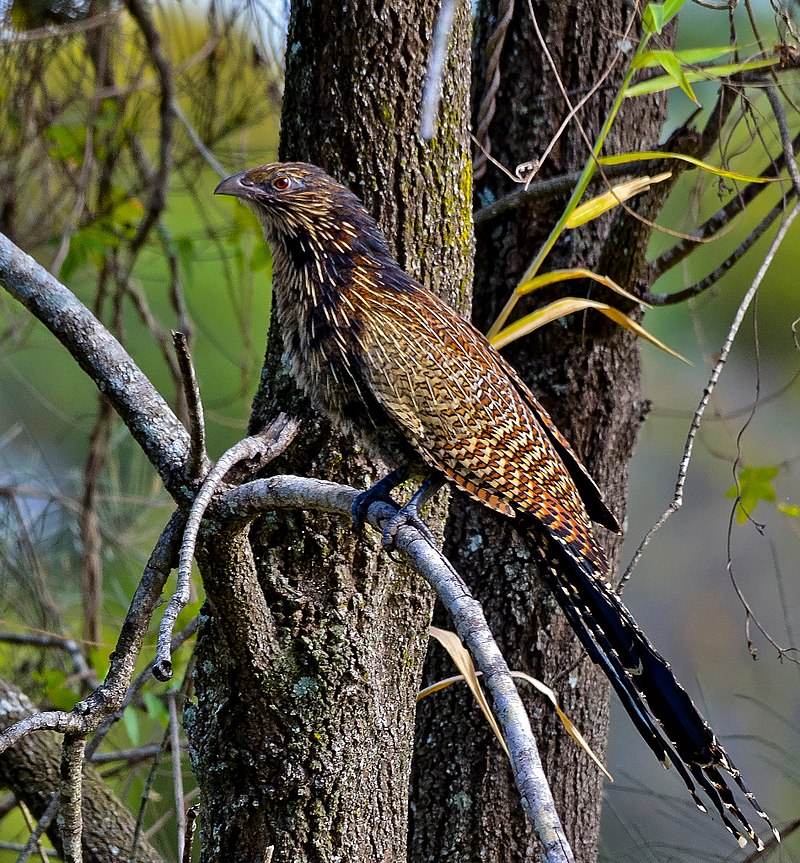
The Pheasant Coucal is a species of cuckoo native to Australia, Timor and New Guinea.
It can be found in subtropical or tropical moist lowland forests as well as mangrove forests but has also adapted well to agricultural areas such as cane fields in Northern Australia.
This makes it an unusual bird among the Australian cuckoos since unlike most other birds from this family, it doesn’t rely on its hosts for incubation and raising offsprings – instead, it does all that by itself.
The female typically lays three eggs which are oval-shaped with light blue colouring that fades over time.
Pheasant coucals have dark brown feathers with some lighter markings around their necks and wings making them look quite unique compared to other birds within the same family.Scientific classification:
| Kingdom | Animalia |
| Phylum | Chordata |
| Class | Aves |
| Order | Cuculiformes |
| Family | Cuculidae |
| Genus | Centropus |
| Species | C. phasianinus |
Also Featured In: Birds that Live in Gold Coasts,
8. Orange-Footed Scrubfowl
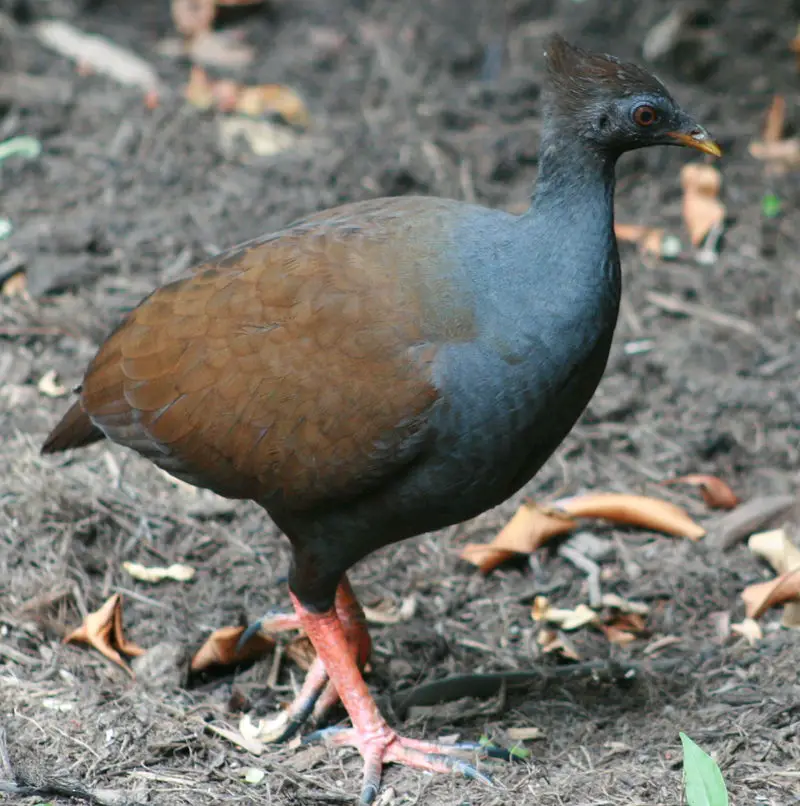
The Orange-footed Scrubfowl is a small Megapode of the family Megapodiidae found in several islands from Lesser Sunda Islands to southern New Guinea and northern Australia.
It has a dark brown coloration with bright orange legs and feet that stand out against its body, making it quite an eye-catching species.
The bird’s size is roughly equal to that of a domestic chicken.
This species feeds mainly on insects, fruits, seeds and roots but will also scavenge for carrion or feed on worms when available.
They are typically solitary birds except during breeding season when they tend to form colonies near their nesting sites usually along beaches or sand dunes where they can use the heat generated by the sun reflecting off the sand in order to incubate their eggs without having build nests themselves.
Overall this unique bird stands apart from other members of its family due to its striking plumage as well as being one of few ground dwelling megapodes instead of tree dwellers like most others within this group which makes them relatively easy to spot among greenery if you know what you’re looking for.Scientific classification:
| Kingdom | Animalia |
| Phylum | Chordata |
| Class | Aves |
| Order | Galliformes |
| Family | Megapodiidae |
| Genus | Megapodius |
| Species | M. reinwardt |
9. Bush Stone-Curlew
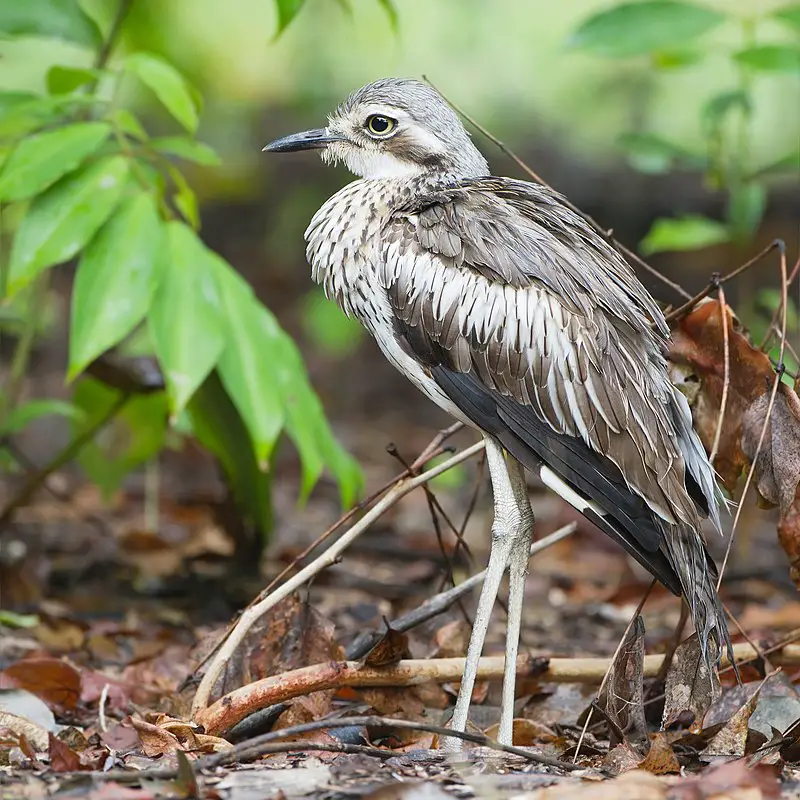
The Bush Stone-Curlew, also known as the Iben Bird, is an endemic species of Australia found in open plains and woodlands. It has grey-brown coloration with dark streaks and large eyes, making it easy to identify.
During night time this bird looks for invertebrates such as insects by slowly stalking its prey. Its long legs allow it to easily traverse across vast landscapes while hunting for food.
The Bush Stone-Curlew plays a vital role in maintaining balance within the ecosystem through controlling insect population growth which can be damaging if not monitored carefully.
Unfortunately due to human interference this species has become endangered so all efforts should be made towards conserving them before they are lost forever from our planet’s biodiversity.Scientific classification:
| Kingdom | Animalia |
| Phylum | Chordata |
| Class | Aves |
| Order | Charadriiformes |
| Family | Burhinidae |
| Genus | Burhinus |
| Species | B. grallarius |
10. Masked Lapwing
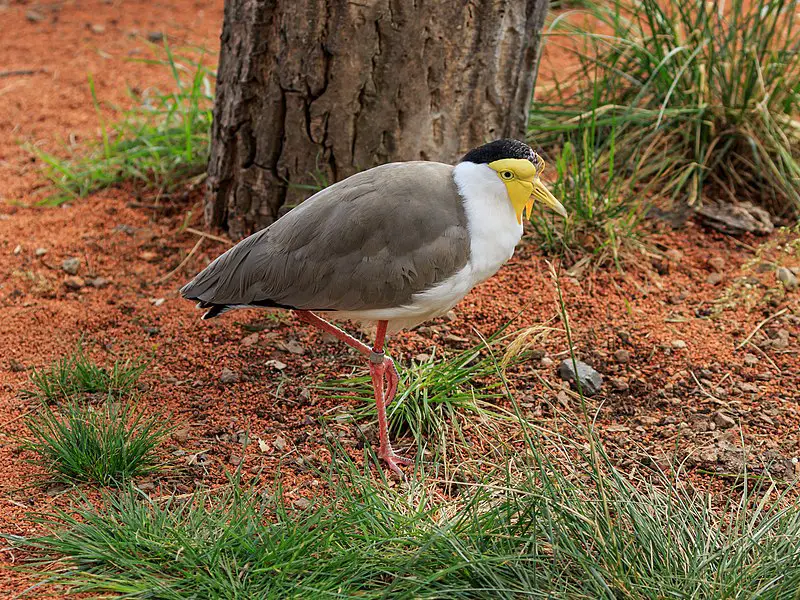
The Masked Lapwing is a large, distinctive bird that can be found in Australia, New Zealand and parts of Papua New Guinea.
It spends most of its time on the ground searching for food such as insects and worms, making it an important part of the local ecology.
It has several loud calls that are easily recognisable – from its ‘kwee-ep’ alarm call to its territorial ‘chi-wick’ call.
The Masked Lapwing is particularly known for swooping down when disturbed or threatened; however this behaviour serves to protect their nests with chicks during breeding season.
They inhabit open fields and grasslands which makes them easy to see if you’re lucky enough.Scientific classification:
| Kingdom | Animalia |
| Phylum | Chordata |
| Class | Aves |
| Order | Charadriiformes |
| Family | Charadriidae |
| Genus | Vanellus |
| Species | V. miles |
Also Featured In: Birds of Tasmania,
11. Common Emerald Dove
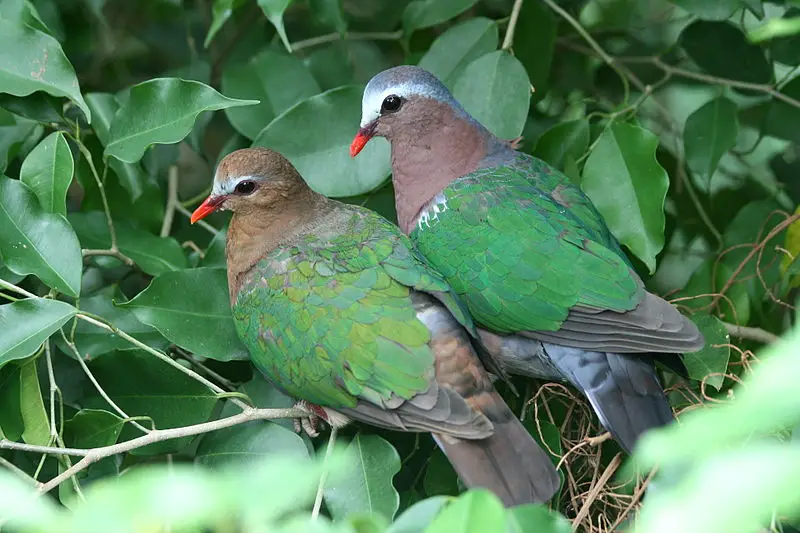
The Common Emerald Dove is a beautiful bird that can be found in tropical and subtropical parts of the Indian Subcontinent and Southeast Asia.
Its distinctive features include its grey-capped head, while its wings are an emerald green colour.
It has also earned itself the nickname “green dove” or “green-winged pigeon”. This species plays an important role in Tamil Nadu’s ecology, which makes it fitting for them to have named it their state bird.
The Pacifric Emerald Dove is closely related to this species but they differ slightly in appearance and habitat preferences; however both make great pets due to being gentle by nature.Scientific classification:
| Kingdom | Animalia |
| Phylum | Chordata |
| Class | Aves |
| Order | Columbiformes |
| Family | Columbidae |
| Genus | Chalcophaps |
| Species | C. indica |
Also Featured In: Birds in Sri Lanka, Birds that Live in Tamil Nadu
12. Magpie Goose
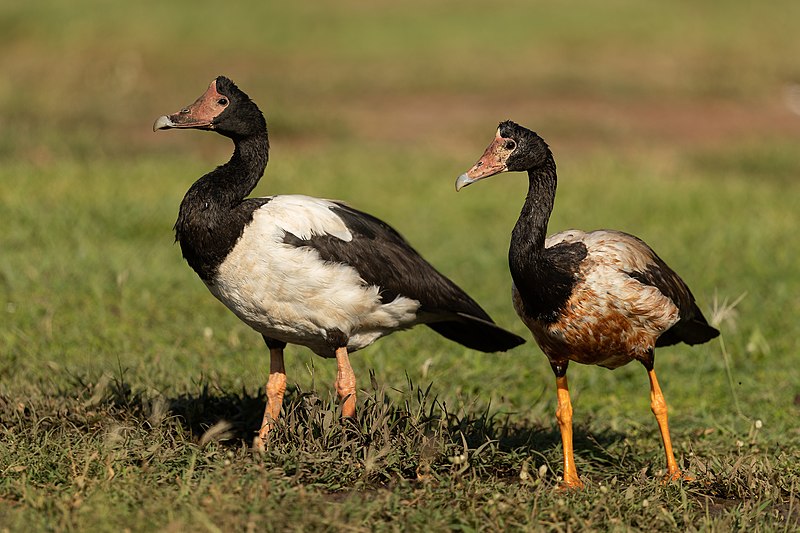
The Magpie Goose is a unique waterbird native to northern Australia and southern New Guinea. It can sometimes be found outside its range due to wandering, but was once widespread in southern Australia until it disappeared.
This species has a distinctive black-and-white plumage with an orange bill and feet which makes them easily recognisable amongst other birds.
They usually live in small flocks around wetlands where they feed on aquatic plants and insects, as well as grain crops when available.
The magpie goose nests near the ground or atop tall vegetation such as reeds or shrubs, laying eggs that are incubated by both parents for up to 30 days before hatching into fluffy yellow goslings.
These beautiful geese have adapted over time so they can survive even during dry periods of their habitats making them an integral part of many wetland ecosystems across Northern Australia and Southern New GuineaScientific classification:
| Kingdom | Animalia |
| Phylum | Chordata |
| Class | Aves |
| Order | Anseriformes |
| Family | Anseranatidae |
| Genus | Anseranas Lesson, 1828 |
| Species | A. semipalmata |
Also Featured In: Papua New Guinea birds,
13. Barking Owl
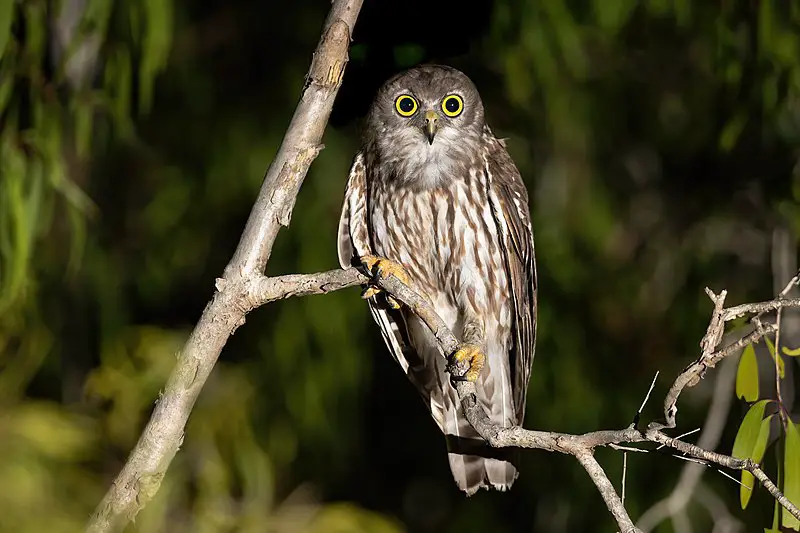
The Barking Owl is a medium-sized brown owl native to Australia, New Guinea and the Moluccas. It has a distinct barking or howling call which gives it its name.
They are nocturnal birds who hunt small prey such as insects, mammals and reptiles at night. The males have larger heads and longer wings than females making them more easily identifiable in flight.
During the day they roost in dense foliage providing excellent camouflage against potential predators.
Their diet consists of rodents, rabbits and some smaller birds like finches or doves but they also eat invertebrates like spiders, worms and frogs too.
With their large eyes adapted for night vision these owls can spot even tiny movement from far away allowing them to catch unsuspecting prey with ease.Scientific classification:
| Kingdom | Animalia |
| Phylum | Chordata |
| Class | Aves |
| Order | Strigiformes |
| Family | Strigidae |
| Genus | Ninox |
| Species | N. connivens |
14. Red-Backed Buttonquail
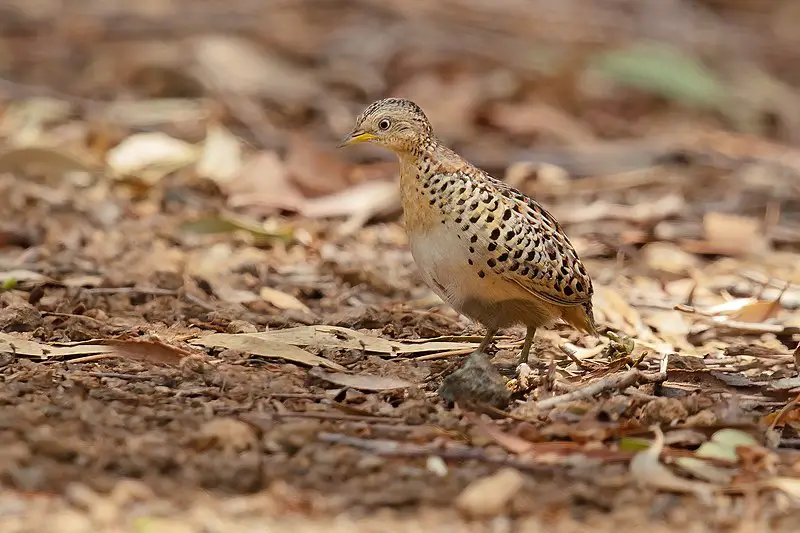
The red-backed buttonquail is a small ground bird found in Australia, Indonesia, Papua New Guinea, the Philippines and the Solomon Islands.
It has fourteen recognised subspecies and can be known by names such as black-backed or orange-breasted buttonquail.
These birds are usually seen alone or in pairs but never more than four together at any one time. With its distinctive mottled brown feathers it blends into its environment seamlessly so that they may be hard to spot even when close up.
The diet of this species consists mainly of seeds which they scratch from the soil using their feet; however insects make up an important part of their diet too.
They live mostly on open grasslands with scattered shrubs for cover where there is plenty of food available throughout the year making them well suited to living in these areasScientific classification:
| Kingdom | Animalia |
| Phylum | Chordata |
| Class | Aves |
| Order | Charadriiformes |
| Family | Turnicidae |
| Genus | Turnix |
| Species | T. maculosus |
Also Featured In: Timor-Leste birds,
15. White-Bellied Cuckooshrike
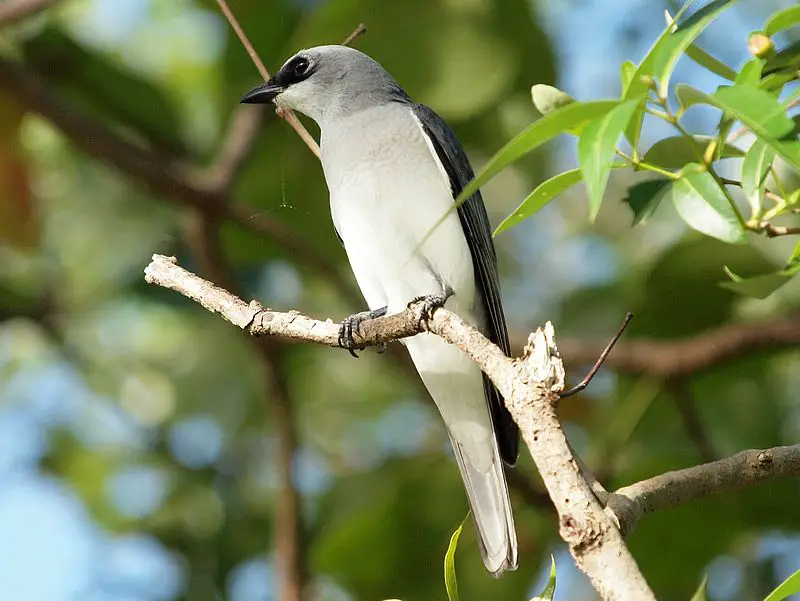
The white-bellied cuckooshrike is a captivating bird found in Australia, the Moluccas, New Guinea and the Solomon Islands.
It has an alluring appearance with its pale blue-grey head and upperparts combined with a short black mask that extends from its beak to its eyes (Lores), finishing off with a fine white rear eye-ring.
Its wings are rounded which help it soar through open woodlands usually as part of mixed species flocks.
This amazing creature enjoys eating insects such as butterflies and moths caught on wing at night or during twilight hours but will also feed on fruit when available.
The White bellied Cuckooshrike is truly an extraordinary example of nature’s beauty.Scientific classification:
| Kingdom | Animalia |
| Phylum | Chordata |
| Class | Aves |
| Order | Passeriformes |
| Family | Campephagidae |
| Genus | Coracina |
| Species | C. papuensis |
Also Featured In: Solomon Islands birds, Bougainville Island Birds You Need to See
16. Brown Goshawk
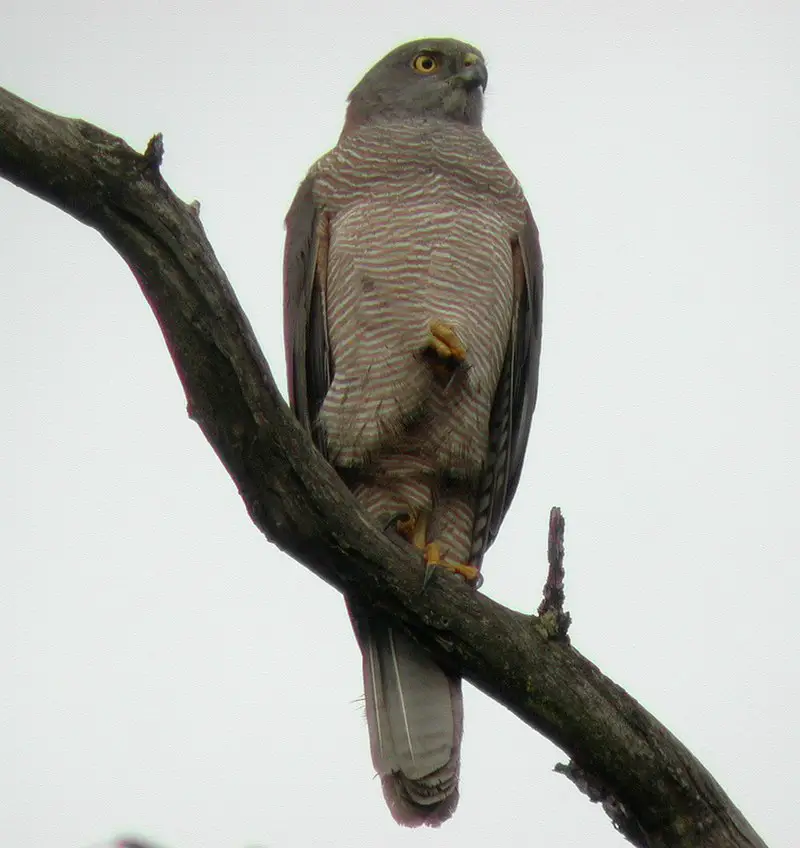
The Brown Goshawk is a medium-sized bird of prey that can be found in Australia and its surrounding islands.
It has grey upperparts with chestnut collar, while the underparts are mainly rufous finely barred with white.
This gives it similar colouring to collared sparrowhawk but it is larger as compared to them; body length being between 40-55 cm.
The flight of this majestic raptor is fast and flexible making for an impressive sight when spotted in the sky.
Its diet consists mostly of small birds, mammals such as rodents or bats, large insects like grasshoppers etc., thus playing an important role in maintaining balance within local ecosystems by controlling population numbers these species.Scientific classification:
| Kingdom | Animalia |
| Phylum | Chordata |
| Class | Aves |
| Order | Accipitriformes |
| Family | Accipitridae |
| Genus | Accipiter |
| Species | A. fasciatus |
Also Featured In: Vanuatu birds, Common Flinders Island Birds
17. Large Ground Finch
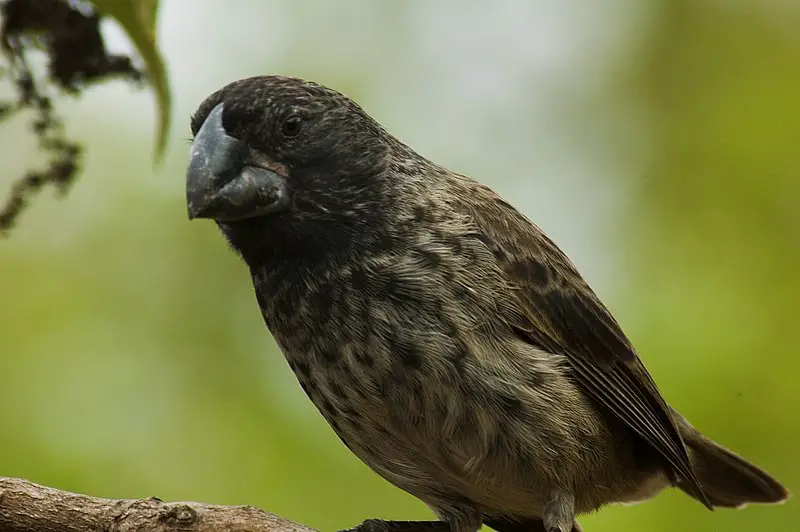
The Large Ground Finch is a species of bird from the Galapagos Islands and is part of Darwin’s Finches.
It belongs to the family Thraupidae, and its habitat ranges across most islands in the archipelago apart from Floreana, Española, San Cristobal and Santa Fe.
This finch stands out as one of the largest amongst all other species due to its large bill size relative to body mass which can reach up to 8 cm long for males.
Its diet consists mainly of seeds but it also feeds on insects during breeding season.
The conservation status for this species is listed as least concern by IUCN Red List because it has an extensive range with stable population numbers despite some fluctuations caused by droughts or food shortages.Scientific classification:
| Kingdom | Animalia |
| Phylum | Chordata |
| Class | Aves |
| Order | Passeriformes |
| Family | Thraupidae |
| Genus | Geospiza |
| Species | G. magnirostris |
Also Featured In: Finches Species, Galapagos Birds You Should Know
18. Common Cactus Finch
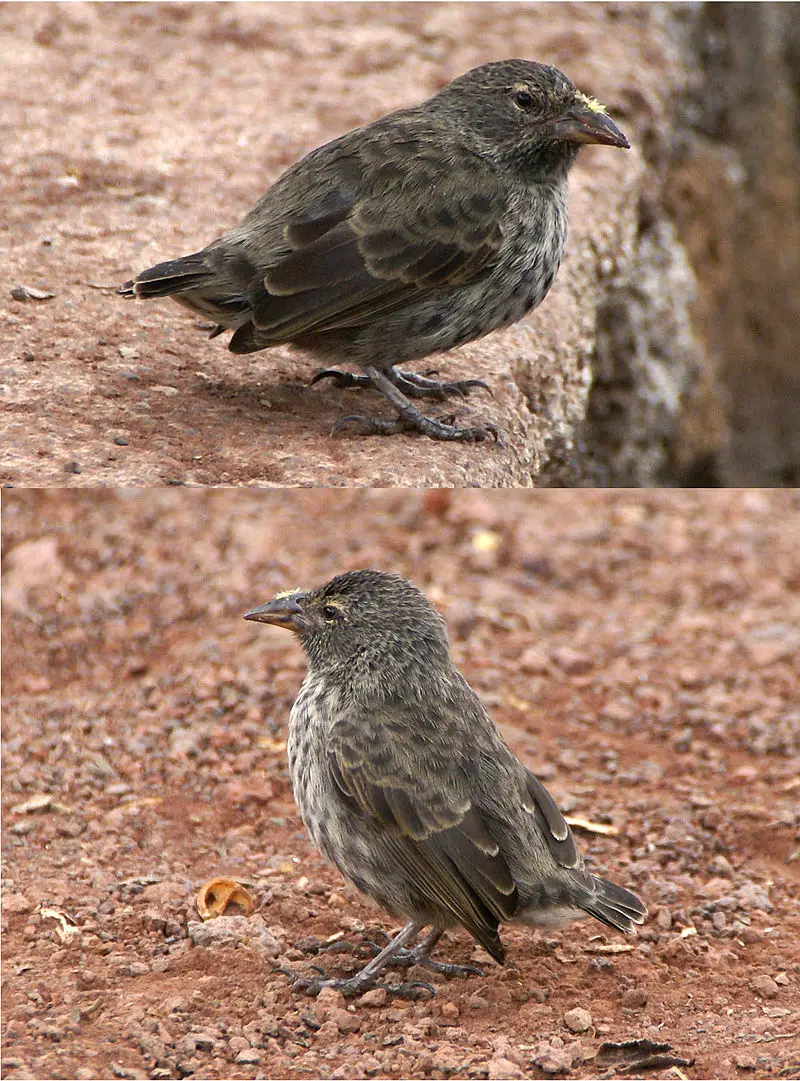
The Common Cactus Finch is a species of bird found in the Darwin’s finch group of the tanager family. It is endemic to Galapagos Islands, with exception on Fernandina, Española, Genovesa, Darwin and Wolf.
This small cacti-eating finch has an olive back and wings that are brownish grey while its chest varies from yellow to pink depending on its habitat.
They feed mainly by probing for insects in crevices or gleaning them off branches from lower trees and shrubs as well as consuming some fruits like cactus pads.
The male common cactus finches have a distinctive song which help attract females during courtship displays whereas females build nests out of twigs lined with soft grasses near ground level under bushes or low vegetation for their eggs.Scientific classification:
| Kingdom | Animalia |
| Phylum | Chordata |
| Class | Aves |
| Order | Passeriformes |
| Family | Thraupidae |
| Genus | Geospiza |
| Species | G. scandens |
Also Featured In: Birds of Galápagos Islands You Need to Know,
19. Double-Barred Finch
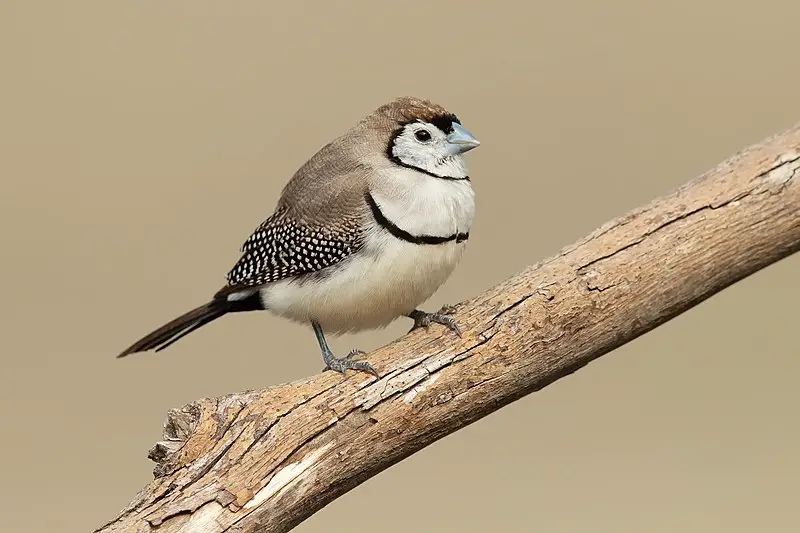
The Double-barred Finch is a species of estrildid finch native to Australia. It inhabits dry savannah, tropical grasslands and shrubland habitats in northern and eastern regions of the country.
The bird has distinctive dark rings around its face that gives it an owl-like appearance; hence one of its common names – Owl Finch.
This small passerine measures up to 12 cm long with a black head, white eyestripes, yellow throat patch and two bars on each wing which give it its name.
These birds are seed eaters but will also feed on insects when breeding season arrives in summer months.
They live in flocks which move from place to place looking for food sources or shelter during extreme weather conditions such as drought or heavy rainsScientific classification:
| Kingdom | Animalia |
| Phylum | Chordata |
| Class | Aves |
| Order | Passeriformes |
| Family | Estrildidae |
| Genus | Stizoptera Oberholser, 1899 |
| Species | S. bichenovii |
20. Azure Kingfisher
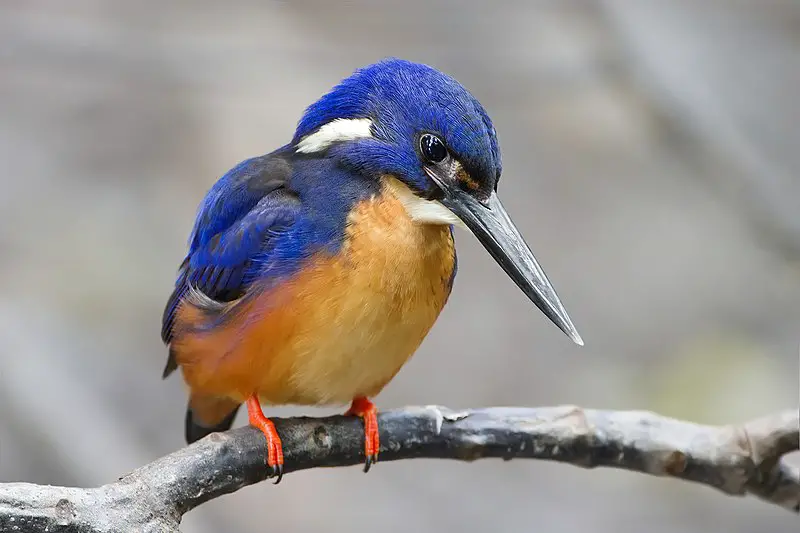
The Azure Kingfisher is a small and beautiful bird, easily recognized by its deep blue to azure back. It measures 17–19 cm in length with males weighing 29-32g and females 31-35g.
On the side of its neck there are large white to buff spots which further adds to the beauty of this species.
This kingfisher inhabits freshwater streams and rivers throughout Australia as well as New Guinea where it can be seen perching on branches next to water bodies or diving for food such as fish, frogs, aquatic insects, molluscs etc.
The Azure Kingfisher has an important role in maintaining healthy river ecosystems while also providing enjoyment when observed in their natural habitats.Scientific classification:
| Kingdom | Animalia |
| Phylum | Chordata |
| Class | Aves |
| Order | Coraciiformes |
| Family | Alcedinidae |
| Subfamily | Alcedininae |
| Genus | Ceyx |
| Species | C. azureus |
Also Featured In: Kingfishers Species, Birds that Found in Kakadu National Park
21. Black-Necked Stork
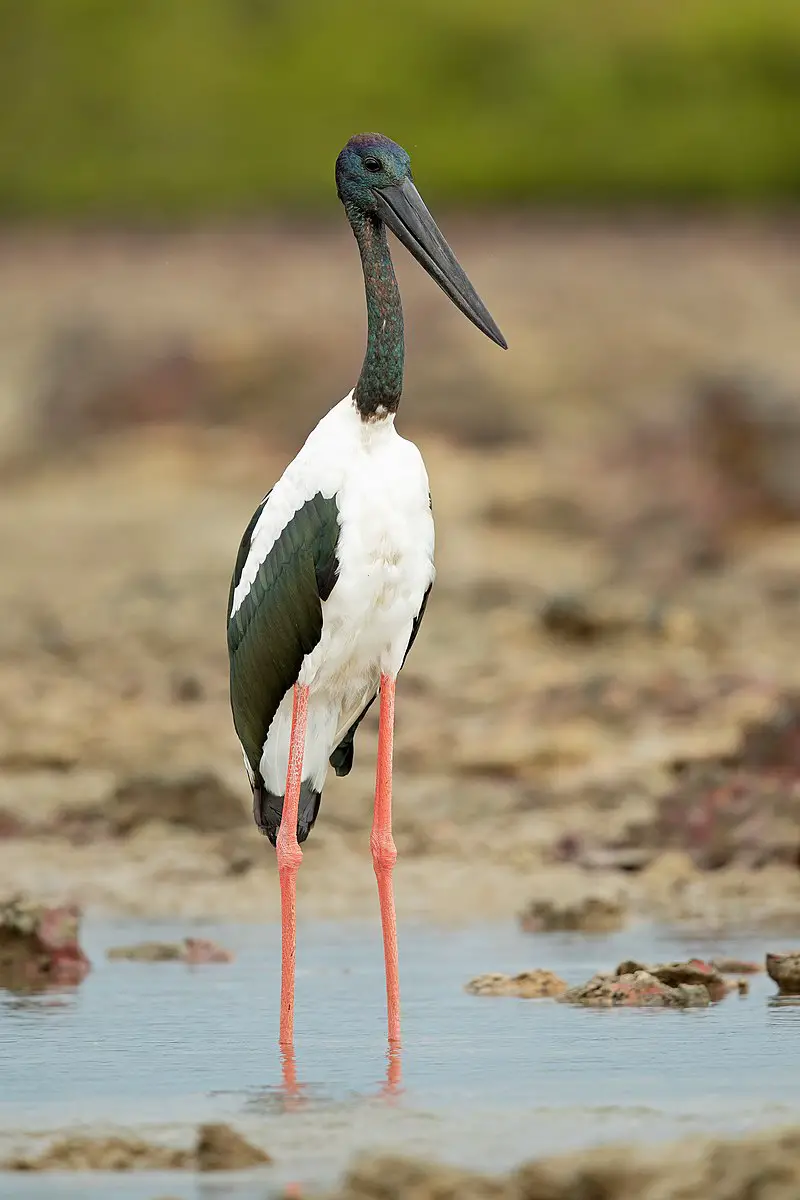
The black-necked stork is a magnificent wading bird in the stork family. With its long neck, striking colours and impressive size, this species is easily recognized across much of India and Southeast Asia as well as Australia.
This adaptable bird can be found in wetlands such as marshes, lagoons and rivers but also frequents nearby crop fields where it feeds on a variety of animal prey including amphibians, fish and small reptiles.
Both sexes have an imposing bill which they use to catch food or perform intricate courtship rituals during breeding season that involve bowing their heads low then jerking them back up again several times.
Their feathers are predominantly dark grey with white patches under the wings while the head has glossy greenish-black plumage; making for stunningly beautiful creatures indeed.Scientific classification:
| Kingdom | Animalia |
| Phylum | Chordata |
| Class | Aves |
| Order | Ciconiiformes |
| Family | Ciconiidae |
| Genus | Ephippiorhynchus |
| Species | E. asiaticus |
Also Featured In: Stork Species, Common Birds of Jharkhand
22. Torresian Crow
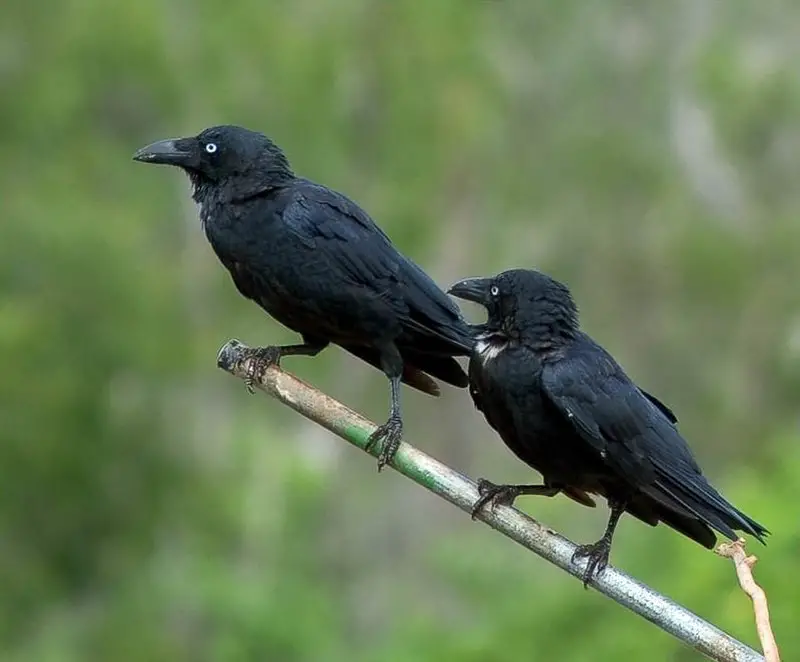
The Torresian crow, also known as the Australian crow or Papuan crow, is a black-plumaged bird with white irises.
It can be found in the north and west of Australia as well as islands in Indonesia and Papua New Guinea.
The bird species possesses a robust build, and the base of its feathers on the head and neck are white. These crows are slightly larger than other crow species.
They belong to the passerine bird family and have a unique beak and mouth.
Although they are widely distributed, some populations of the Torresian crow may be declining due to habitat loss and other threats.
Overall, the Torresian crow is an interesting bird that has adapted to survive in a range of environments.Scientific classification:
| Kingdom | Animalia |
| Phylum | Chordata |
| Class | Aves |
| Order | Passeriformes |
| Family | Corvidae |
| Genus | Corvus |
| Species | C. orru |
Also Featured In: Birds that Live around Brisbane,
23. Little Friarbird
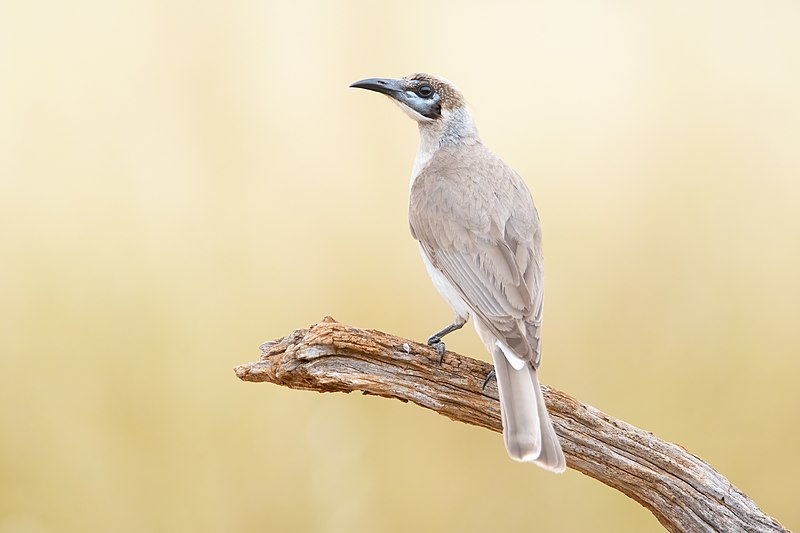
The Little Friarbird, also called Yellow-throated Friarbird, is a small bird native to northern and eastern Australia and southern Papua New Guinea. This species of bird belongs to the Philemon genus and is the smallest of the friarbirds.
It lives a very active life, often seen chasing other honeyeaters and can be quite vocal.
Despite its small size, it is easy to spot and recognize due to its distinct yellow throat feathers. This bird species has adapted well to its environment and is a common sight in its range.
The Little Friarbird is a fascinating bird and is a great addition to any bird watching excursion in Australia or southern Papua New Guinea.Scientific classification:
| Kingdom | Animalia |
| Phylum | Chordata |
| Class | Aves |
| Order | Passeriformes |
| Family | Meliphagidae |
| Genus | Philemon |
| Species | P. citreogularis |
Also Featured In: Common Townsville Birds,
24. Olive-Backed Oriole
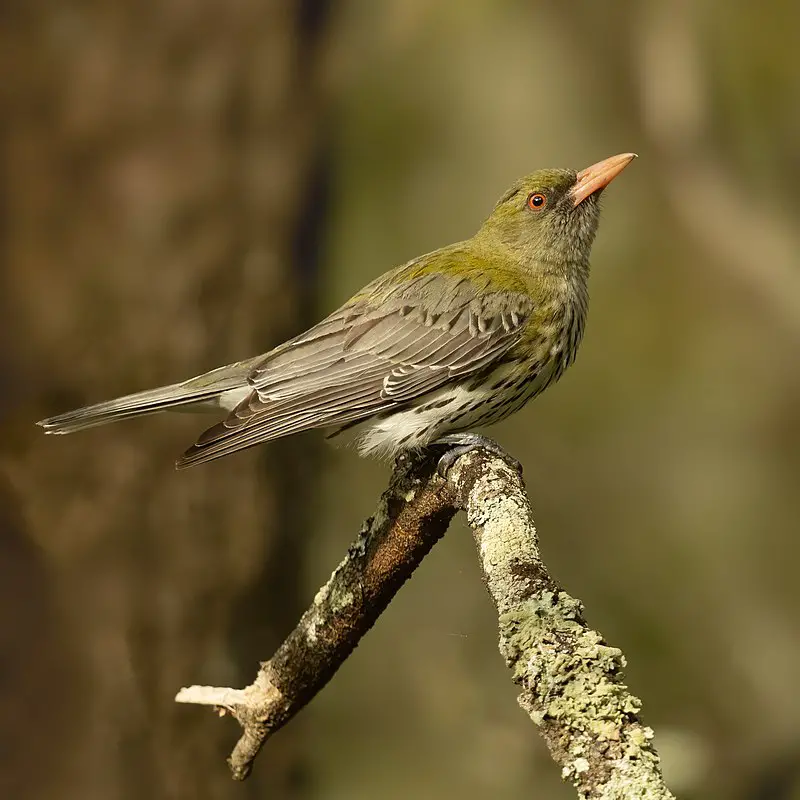
The olive-backed oriole is a medium-sized bird found in northern and eastern Australia and south-central New Guinea. It is known for its noisy and conspicuous behavior, making it easy to spot.
This bird was first described by John Latham in 1801, and is the most widespread Australasian oriole. With its distinctive white belly, this bird is a common sight among trees and bushes.
The olive-backed oriole belongs to the Coracias genus and has four sub-species.
It is a passerine bird that is often vocal, producing a range of calls and songs. If you’re ever in northern or eastern Australia or south-central New Guinea, keep an eye out for the olive-backed oriole and its beautiful plumage.Scientific classification:
| Kingdom | Animalia |
| Phylum | Chordata |
| Class | Aves |
| Order | Passeriformes |
| Family | Oriolidae |
| Genus | Oriolus |
| Species | O. sagittatus |
Also Featured In: Birds that Live in Sunshine Coast, Native Birds Of Mackay
25. Hardhead
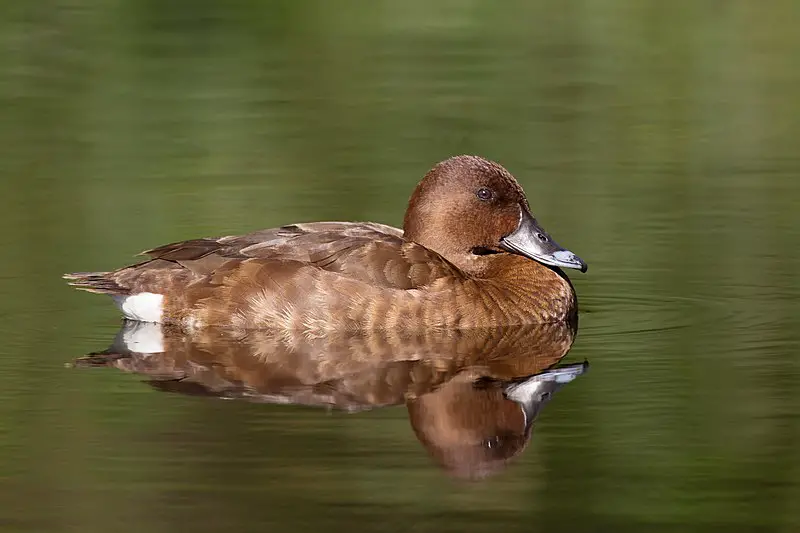
The Hardhead bird, scientifically known as Aythya australis, is the only genuine diving duck found in Australia. Its common name, “hardhead,” refers to the taxidermists’ difficulty processing its head, not its skull’s density.
These birds are typically found in wet coastal regions of Australia, mainly in the southeast. They have white eyes and are usually grey or black with a bluish-black bill.
As diving ducks, Hardheads dive deep into the water to forage for aquatic plants, mollusks, and invertebrates.
They are relatively quiet birds with a harsh, low quack sound. Hardheads play an important role in aquatic ecosystems as they help to control the growth of certain plants, keep waterways clean, and are preyed upon by larger birds and reptiles.Scientific classification:
| Kingdom | Animalia |
| Phylum | Chordata |
| Class | Aves |
| Order | Anseriformes |
| Family | Anatidae |
| Genus | Aythya |
| Species | A. australis |
Also Featured In: Sydney Birds You Need to See, New South Wales Birds You Need to See
26. Straw-Necked Ibis
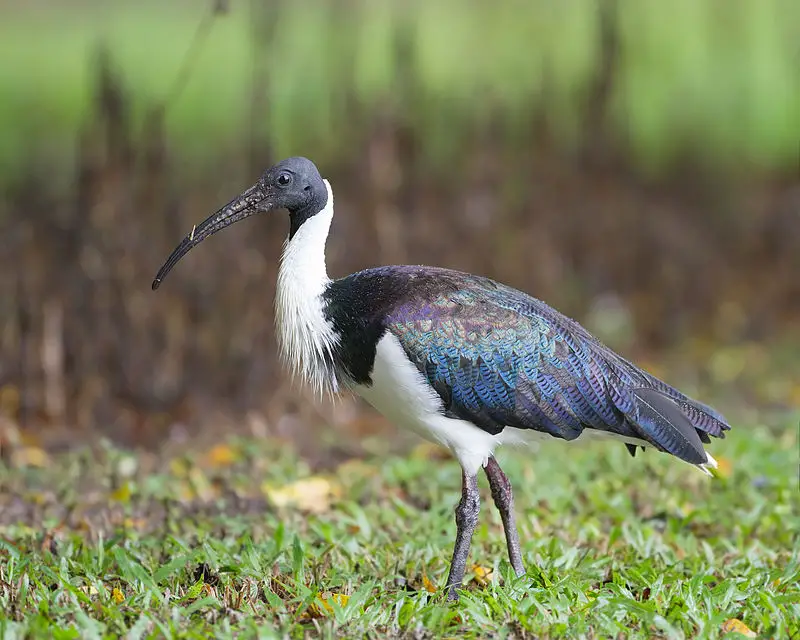
The Straw-necked ibis is a large bird that belongs to the Threskiornithidae family. It can be found in different parts of the world such as Australia, New Guinea, and Indonesia.
These birds are easily identifiable by their distinctive features such as their long, down-curved black bill, bare black head, and straw-like feathers on their necks. They can grow up to 76 cm in length and are known to be active during the day.
The Straw-necked ibis feeds on a variety of things such as insects, frogs, fish, and small reptiles.
They are known for having a loud call that can be heard from a distance. These birds are social creatures that can often be seen in flocks of up to 100 individuals.
The Straw-necked ibis is a beautiful bird that plays an important role in the ecosystem.Scientific classification:
| Kingdom | Animalia |
| Phylum | Chordata |
| Class | Aves |
| Order | Pelecaniformes |
| Family | Threskiornithidae |
| Genus | Threskiornis |
| Species | T. spinicollis |
27. Spangled Drongo
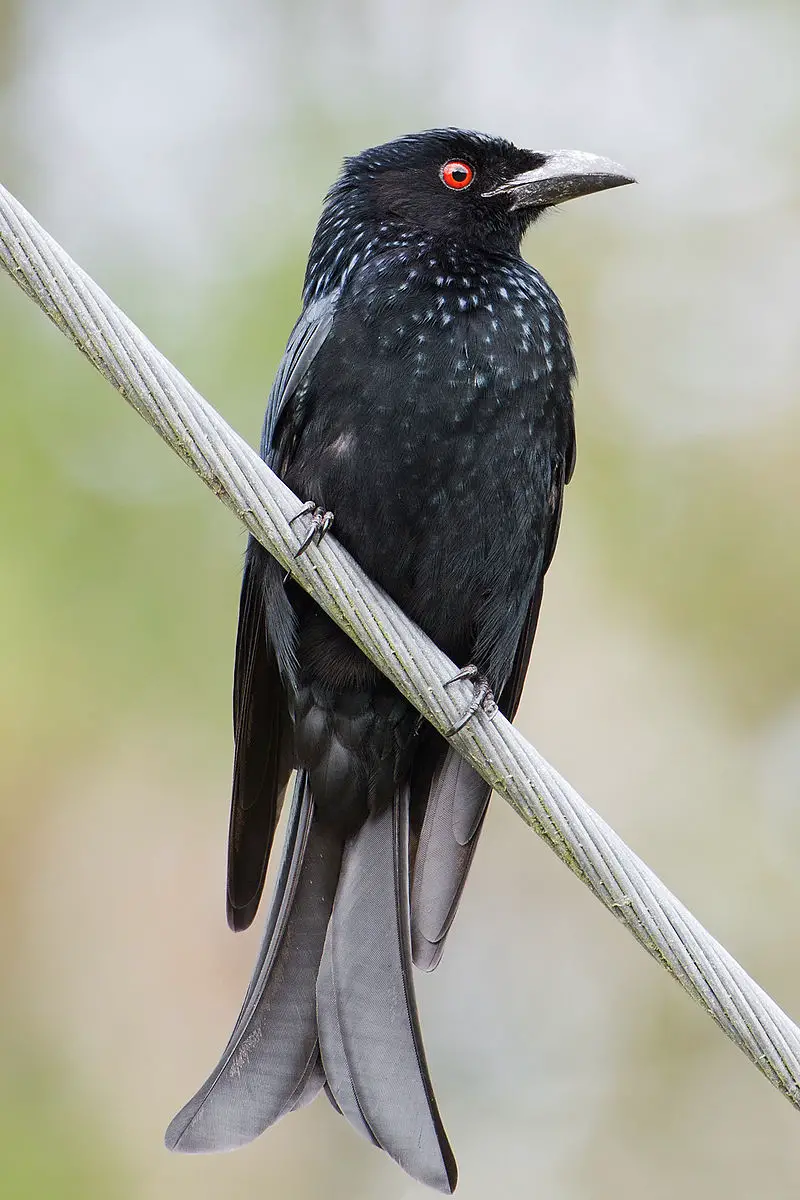
The Spangled drongo is a unique bird found only in Australia. Its black plumage with iridescent shades and forked tail make it easy to identify. It feeds on small animals and insects.
Its call is varied and complex, as it can mimic sounds in its environment. During late spring, it arrives in Queensland to breed in high places.
The Spangled drongo is a fascinating bird for birdwatchers and ornithologists in Australia.Scientific classification:
| Kingdom | Animalia |
| Phylum | Chordata |
| Class | Aves |
| Order | Passeriformes |
| Family | Dicruridae |
| Genus | Dicrurus |
| Species | D. bracteatus |
Also Featured In: Pet Birds that Live in India,
28. Long-Tailed Finch
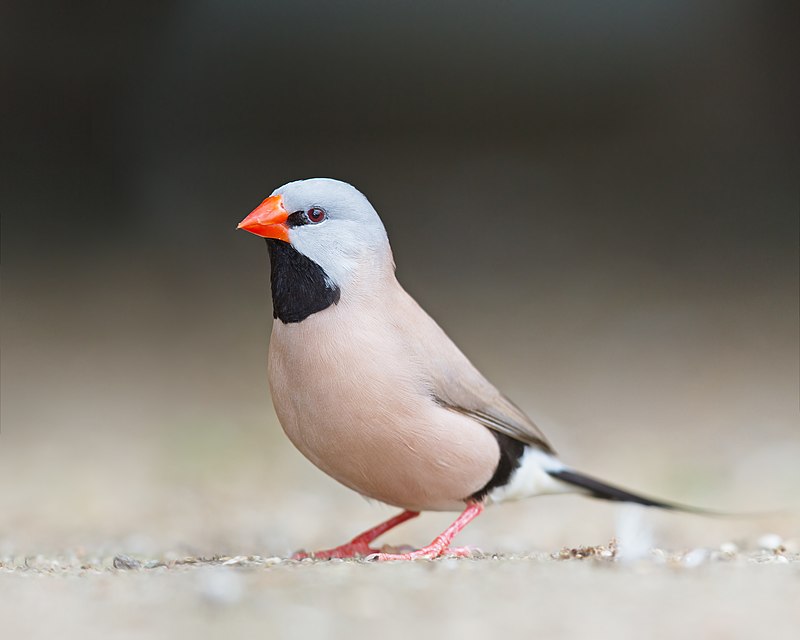
The Long-tailed finch, also known as Poephila acuticauda, is a frequently seen bird in the northern regions of Australia. This finch species is primarily a fawn color with a gray head and notable black bib and eyes.
These birds live in dry savannah habitats and are adaptable to being raised in captivity. The Long-tailed finch is known for its long tail feathers that extend beyond the rest of its body.
First described by scientists in the academic community, this species is common among estrildid finches.
Despite their commonality, these birds are still a beloved part of the Australian bird population and popular pets for those who keep finches in captivity.Scientific classification:
| Kingdom | Animalia |
| Phylum | Chordata |
| Class | Aves |
| Order | Passeriformes |
| Family | Estrildidae |
| Genus | Poephila |
| Species | P. acuticauda |
Also Featured In: Aviary Birds You Should Know,
29. Geospiza
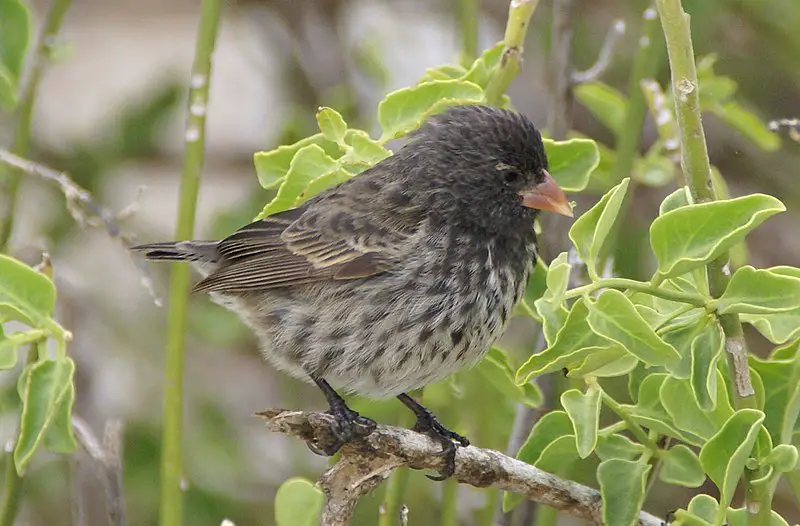
Geospiza is a unique genus of bird that is only found in the Galápagos Islands. They are part of the tanager family and are commonly known as Darwin’s finches.
Their classification has changed over time, with previous placements in the bunting and American sparrow family now being debunked by new studies.
These birds are truly endemic to the Galápagos, meaning that they cannot be found anywhere else in the world.
They are an important part of the ecosystems of the islands and are often studied because of their unique adaptations and evolution.
Geospiza birds are fascinating and represent an important part of the natural history of the world.Scientific classification:
| Kingdom | Animalia |
| Phylum | Chordata |
| Class | Aves |
| Order | Passeriformes |
| Family | Thraupidae |
| Genus | Geospiza Gould, 1837 |
30. Bar-Shouldered Dove
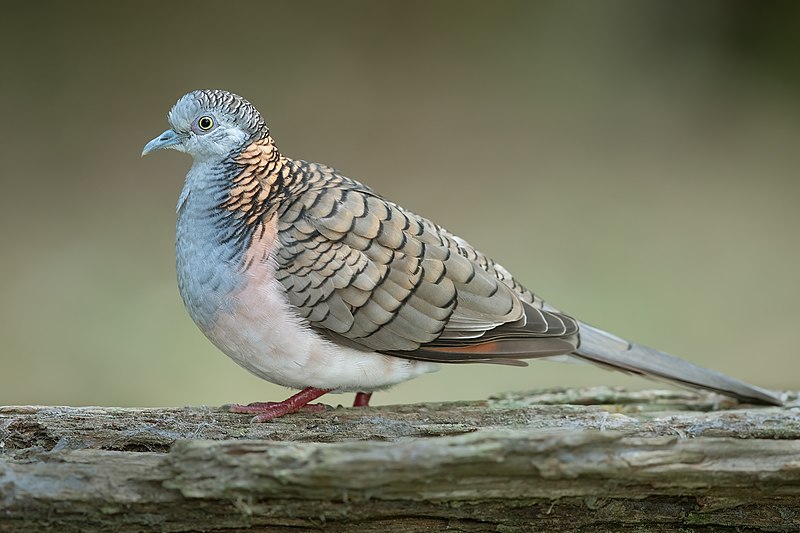
The Bar-shouldered dove, also known as Geopelia humeralis, is a medium-sized pigeon species that can be found in Australia and Southern New Guinea. This bird is protected by the National Parks and Wildlife Act of 1974.
It has a unique and pleasing voice that sounds like “cook-a-wook” or “coolicoo.” Additionally, the Bar-shouldered dove has blue-grey breast feathers and chequered brown-bronze wings. It is quite striking to look at and is known for its long, elegant tail.
This bird is a fascinating species with a lot of fun facts to explore.Scientific classification:
| Kingdom | Animalia |
| Phylum | Chordata |
| Class | Aves |
| Order | Columbiformes |
| Family | Columbidae |
| Genus | Geopelia |
| Species | G. humeralis |
31. Figbird
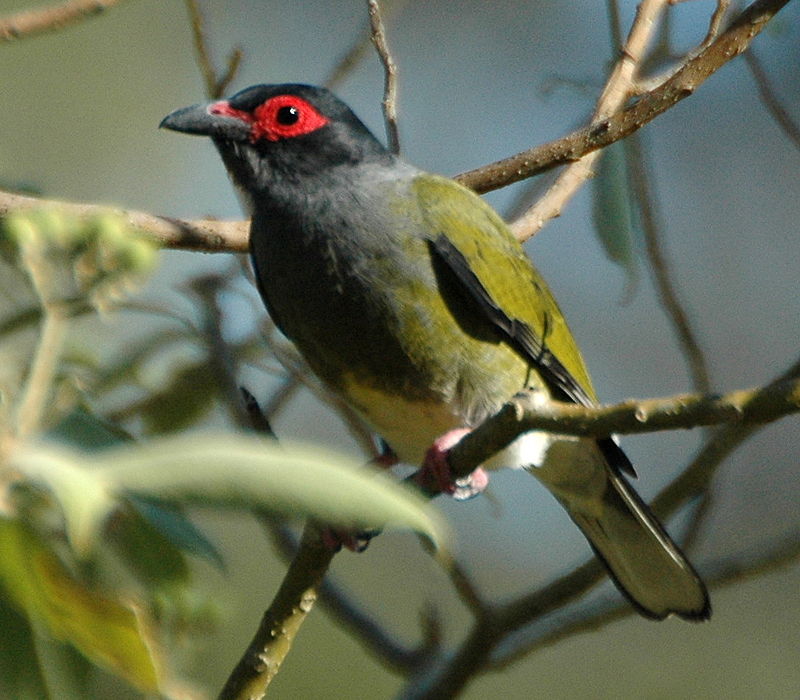
The Figbird is a type of bird found in wooded habitats in Australia, New Guinea, and the Lesser Sundas. It belongs to a genus called Sphecotheres and is part of the family of Old World orioles.
Despite being previously considered as a single species, experts now recognize three separate species based on differences in measurements, plumage, and biogeography.
These differences have led to the split and the reclassification of these birds, which are now known as the Northern Figbird, the Western Figbird, and the Timor Figbird.
With their distinctive appearance and chirpy calls, these birds are a popular subject of study for birdwatchers and ornithologists alike.Scientific classification:
| Kingdom | Animalia |
| Phylum | Chordata |
| Class | Aves |
| Order | Passeriformes |
| Family | Oriolidae |
| Genus | Sphecotheres Vieillot, 1816 |
32. Banded Honeyeater
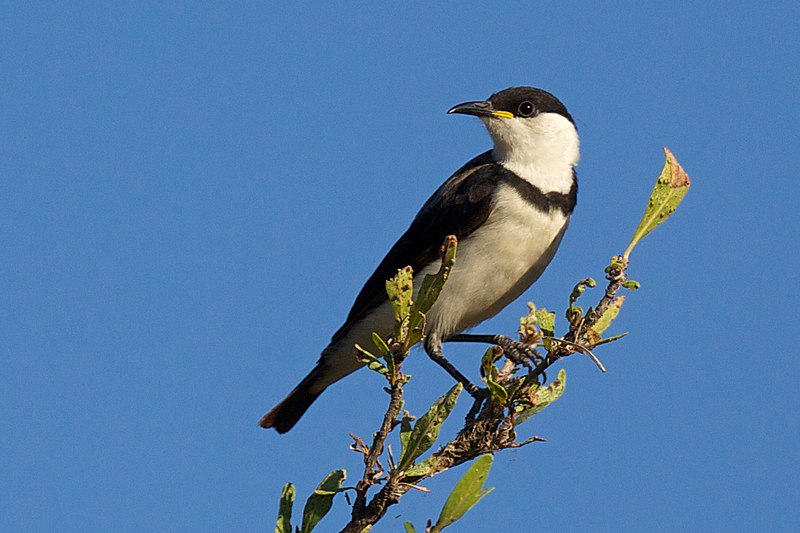
The banded honeyeater is a unique bird found only in tropical northern Australia. It belongs to the Meliphagidae family and is known for its distinctive narrow black band across its white underparts.
The scientific name for this bird is Cissomela pectoralis, with its holotype being a male bird located in the Academy of Natural Sciences. This bird is one of many endemic species found in Australia and is a vital part of its ecosystem.
With its impressive appearance and significance to the environment, the banded honeyeater is a beloved bird among birdwatchers and conservationists alike.Scientific classification:
| Kingdom | Animalia |
| Phylum | Chordata |
| Class | Aves |
| Order | Passeriformes |
| Family | Meliphagidae |
| Genus | Cissomela Bonaparte, 1854 |
| Species | C. pectoralis |
33. Magpie-Lark
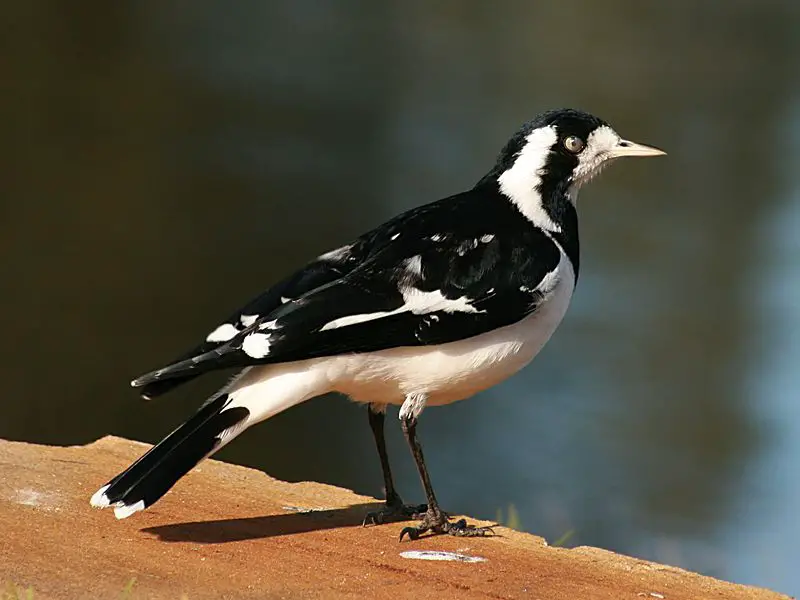
The Magpie-lark is a bird found in Australia, Timor, and southern New Guinea. It has black and white plumage, with different patterns for males and females.
John Latham first described this species in 1801. Formerly known as a mudnest builder, it has been reclassified recently.
The bird has several nicknames such as Wee magpie, Peewee, Peewit, and Mudlark.
It is a passerine bird, and its scientific name is Grallina cyanoleuca. The Magpie-lark is known for its beautiful call, which is similar to the sound “pee-wee.” It is a unique species that adds to the diversity of Australia’s wildlife.
The bird is a favourite among birdwatchers and nature lovers in general.Scientific classification:
| Kingdom | Animalia |
| Phylum | Chordata |
| Class | Aves |
| Order | Passeriformes |
| Family | Monarchidae |
| Genus | Grallina |
| Species | G. cyanoleuca |
Also Featured In: Birds that Live Near Adelaide, Birds that Live around Victoria
34. Red-Winged Parrot
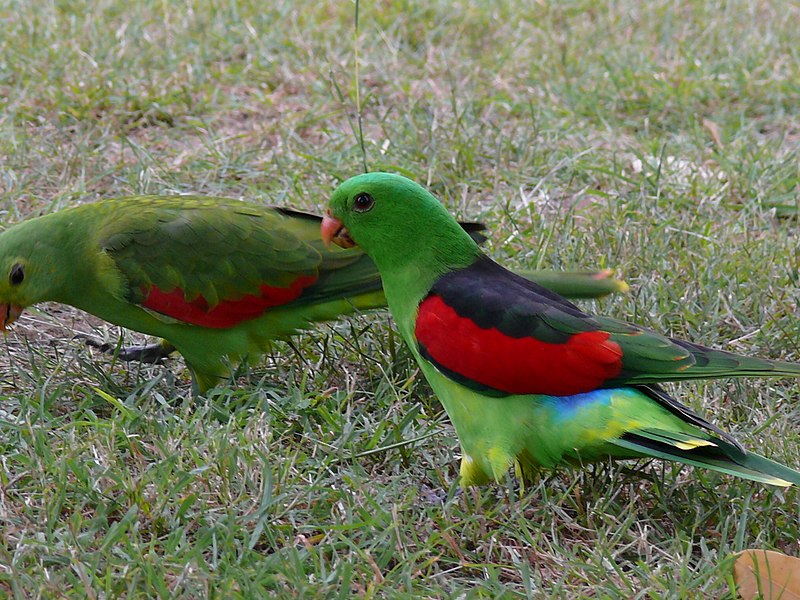
The Red-winged parrot, a beautiful bird found in Australia and New Guinea, inhabits various landscapes including grasslands, savannah, farmland, and woodland.
This parrot species was first identified by Johann Friedrich Gmelin in 1788 who classified it under Psittacus genus with other parrots. Known for their striking red wings, these parrots have a distinctive green plumage with a red patch on their forehead.
They feed mostly on seeds, fruits, and nectar. These social birds live in small flocks and mate for life, breeding during the dry season.
The Red-winged parrot is a delightful bird to watch with their playful, acrobatic flight and entertaining antics. Due to habitat loss, these birds are considered near threatened in some areas.
Conservation efforts are underway to ensure their survival.Scientific classification:
| Kingdom | Animalia |
| Phylum | Chordata |
| Class | Aves |
| Order | Psittaciformes |
| Family | Psittaculidae |
| Genus | Aprosmictus |
| Species | A. erythropterus |
35. Helmeted Friarbird
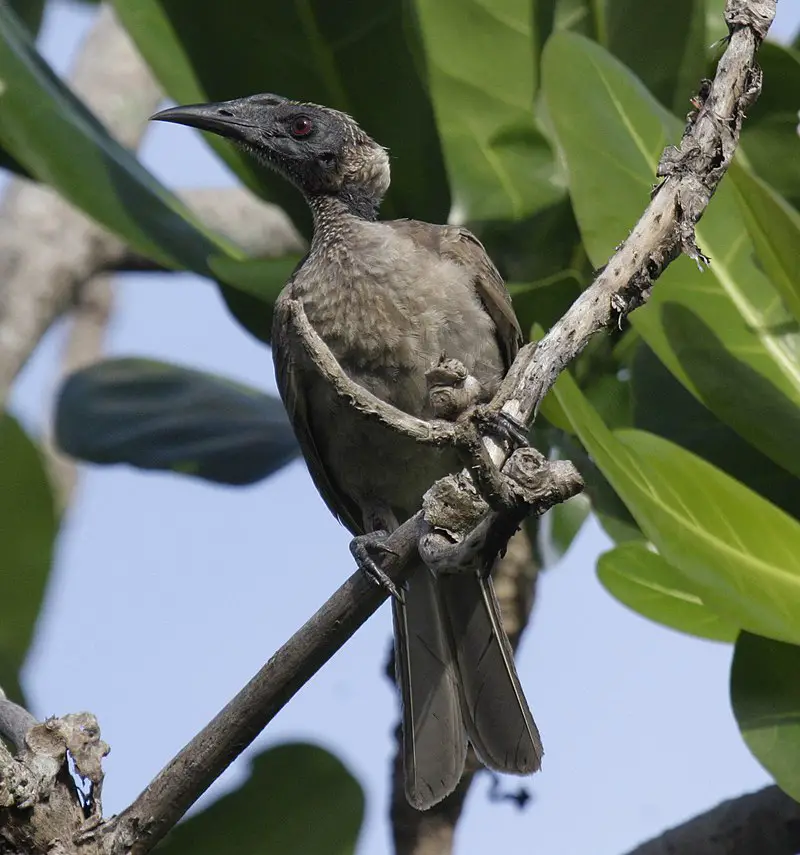
The helmeted friarbird, also known as the “leatherhead,” is a member of the Meliphagidae family of birds. It has a distinctive dark gray face with striking red eyes.
Its overall coloring is gray-brown, with a fading white color around the chest area, which becomes spotted as it gets closer to the feet.
The helmeted friarbird is widespread in Australia and Indonesia, and its subspecies have similar characteristics.
These birds are known for their distinctive appearance and are often spotted by birdwatchers in their natural habitats.
Overall, the helmeted friarbird is a fascinating and unique bird that is worth observing for bird enthusiasts and nature lovers alike.Scientific classification:
| Kingdom | Animalia |
| Phylum | Chordata |
| Class | Aves |
| Order | Passeriformes |
| Family | Meliphagidae |
| Genus | Philemon |
| Species | P. buceroides |
36. Dusky Myzomela
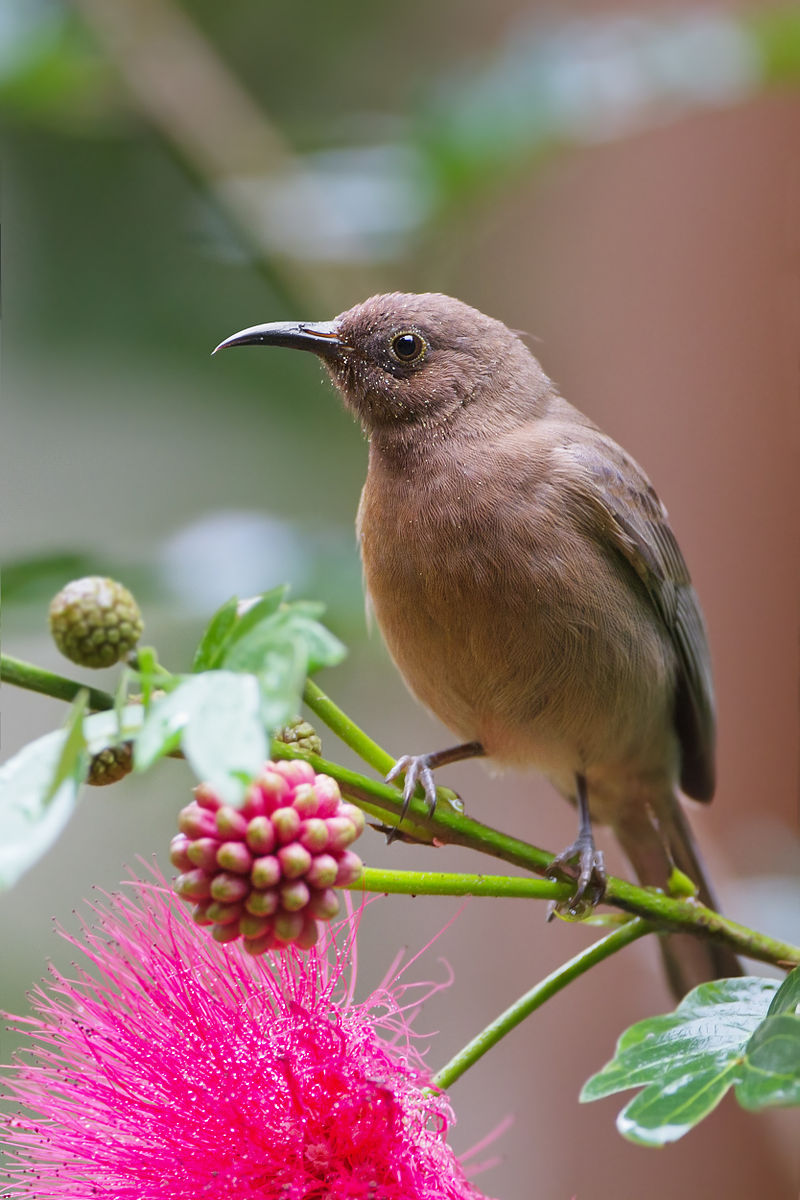
The dusky myzomela, also known as the dusky honeyeater, is a small bird found in the Aru Islands, southern New Guinea, and northern and eastern Australia.
It has two separate populations in Australia, one in the Top End and the other from Cape York Peninsula along the east coast. The bird is brown in color and a common resident of the areas it inhabits.
It is small in size and resembles a honeyeater. However, the dusky myzomela is a rare species south of Rockhampton.Scientific classification:
| Kingdom | Animalia |
| Phylum | Chordata |
| Class | Aves |
| Order | Passeriformes |
| Family | Meliphagidae |
| Genus | Myzomela |
| Species | M. obscura |
37. Grey-Crowned Babbler
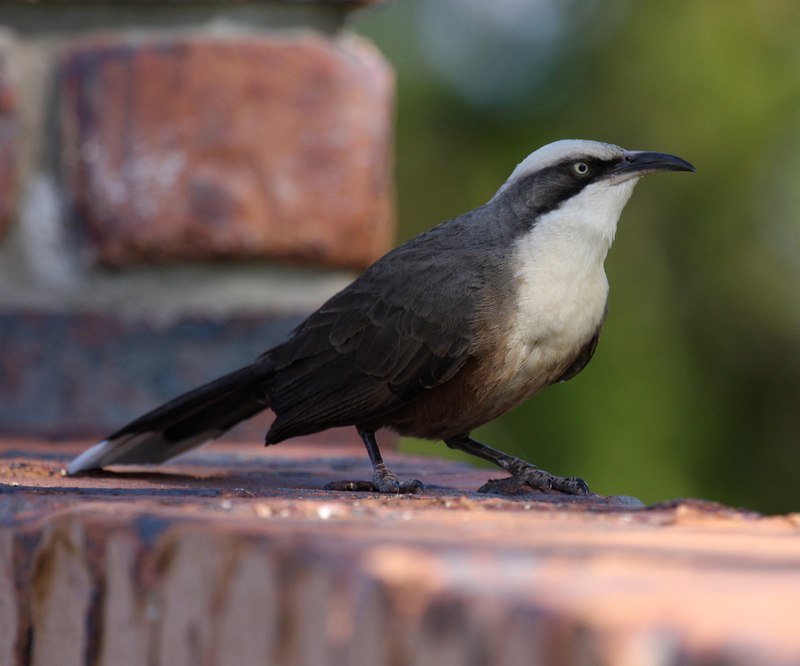
The Grey-crowned babbler is a bird found in Australia, Indonesia and Papua New Guinea. This species belongs to the Pomatostomidae family and inhabits temperate forests and subtropical or tropical moist lowland forests.
It has two recognized subspecies in Australia and New Guinea. The bird is known for its grey-colored crown and is named accordingly.
It is a social bird that travels in groups called ‘tribes’ and has a unique way of communicating through various vocalizations.
The Grey-crowned babblers are non-migratory birds, and they feed on insects and small animals found in the forest. These birds build nests together, and their young are raised collaboratively by the entire tribe.
Grey-crowned babblers have a crucial role in maintaining the ecological balance of their habitats by dispersing seeds and controlling insect populations.Scientific classification:
| Kingdom | Animalia |
| Phylum | Chordata |
| Class | Aves |
| Order | Passeriformes |
| Family | Pomatostomidae |
| Genus | Pomatostomus |
| Species | P. temporalis |
38. Peaceful Dove
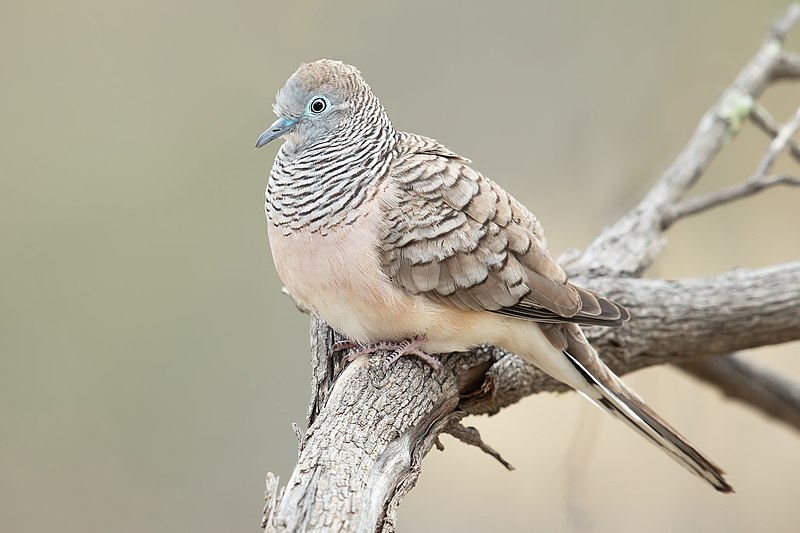
The Peaceful dove is a native bird of Australia and Papua New Guinea. It is a petite pigeon, ranging in size from 19 to 21 centimeters.
This bird belongs to the Geopelia family and is closely related to the Zebra dove of southeast Asia and the Barred dove of eastern Indonesia.
Although until recently, all three species were classified as a single species – Geopelia Striata. The peaceful dove, also known as the Zebra dove, is a peaceful bird with a gentle nature.
Due to their docile temperament, they are often kept as pets. Despite their small size, they are able to fly quickly and gracefully.
The colorful appearance of their feathers, mixed with their pleasant cooing sound, makes the Peaceful dove an enjoyable sight for bird watchers.Scientific classification:
| Kingdom | Animalia |
| Phylum | Chordata |
| Class | Aves |
| Order | Columbiformes |
| Family | Columbidae |
| Genus | Geopelia |
| Species | G. placida |
39. Red-Headed Myzomela
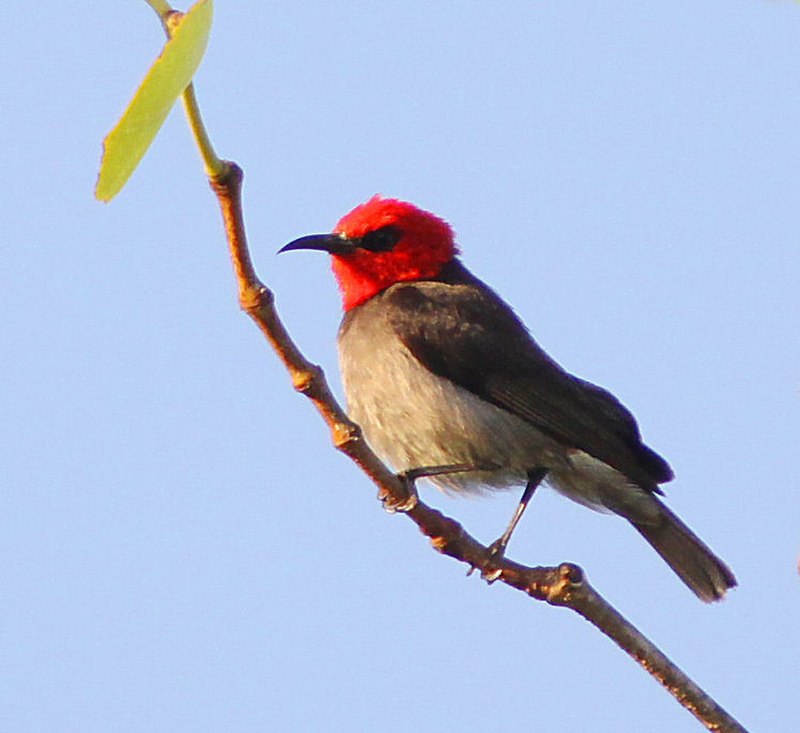
The red-headed myzomela, also known as the red-headed honeyeater, is a small bird that belongs to the Meliphagidae family. It was first described by John Gould in 1840 and is found in Australia, Indonesia, and Papua New Guinea.
The bird has a striking red head and a black and white body. It has two recognized subspecies, with one found on the tropical coastline of Australia and the other in New Guinea. The bird’s preferred habitat includes gardens, forest edges, and mangroves.
It feeds on nectar from flowers and small insects. The red-headed myzomela is known for its beautiful singing and is a popular bird among bird-watching enthusiasts.Scientific classification:
| Kingdom | Animalia |
| Phylum | Chordata |
| Class | Aves |
| Order | Passeriformes |
| Family | Meliphagidae |
| Genus | Myzomela |
| Species | M. erythrocephala |
40. Zitting Cisticola
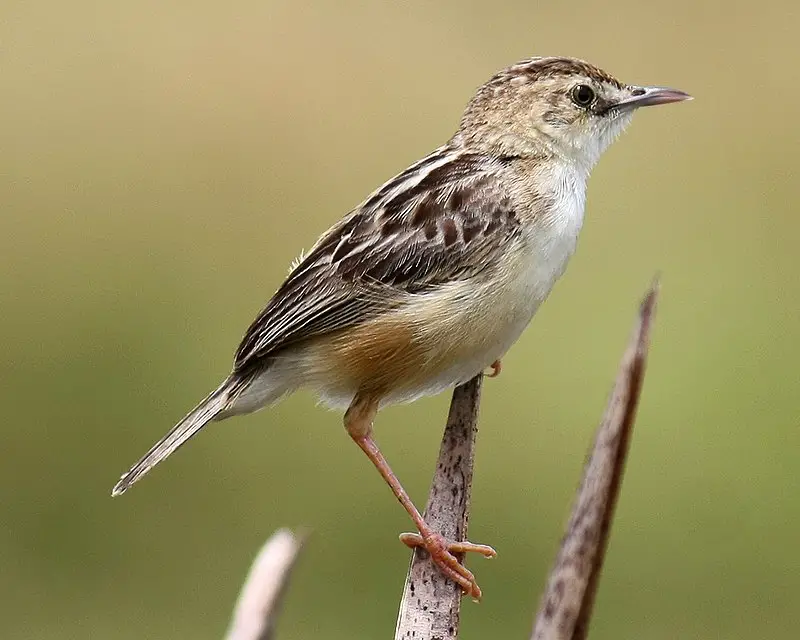
The Zitting cisticola, also known as the streaked fantail warbler, is a small bird found in grasslands across southern Europe, Africa (excluding deserts and rainforests), and southern Asia, down to northern Australia.
It has a distinctive rufous rump and lacks any gold on the collar. Its tail is brownish in color. This Old World warbler is commonly found in open areas with tall grass and feeds on insects.
The Zitting cisticola makes a distinctive sound, described as a “zit-zit-zit,” hence its name.
It is known for performing wonderful displays during breeding season, which involves singing while flying steeply upwards before plummeting downwards with an outspread tail.
Despite being widely distributed, the species is currently considered of “Least Concern” by the International Union for Conservation of Nature (IUCN).Scientific classification:
| Kingdom | Animalia |
| Phylum | Chordata |
| Class | Aves |
| Order | Passeriformes |
| Family | Cisticolidae |
| Genus | Cisticola |
| Species | C. juncidis |
Also Featured In: Most Common Spain Birds, Coastal Birds That Live around Miyako-jima
41. Canary White-Eye
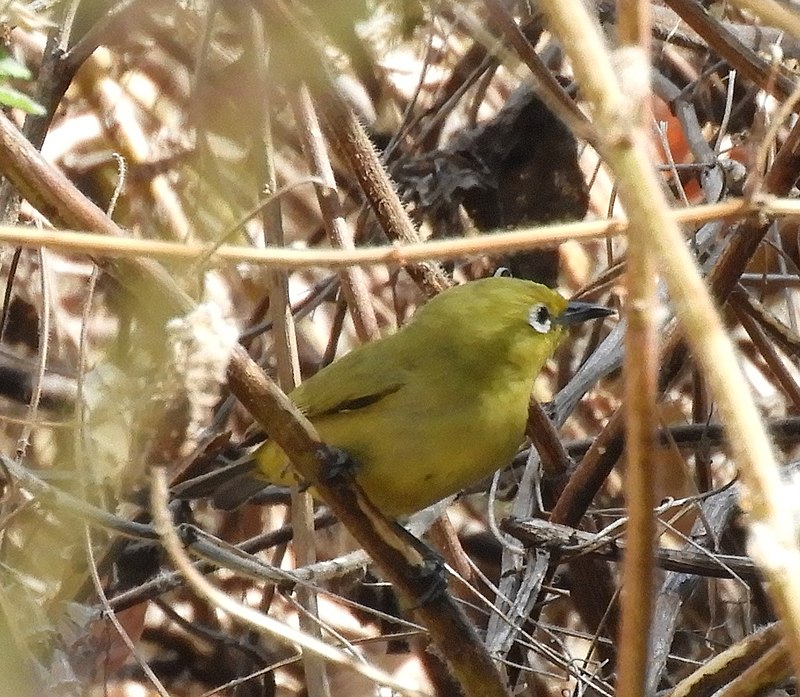
The Canary white-eye bird is endemic to subtropical or tropical mangrove forests in northern Australia. This small bird has a bright olive back and yellow underparts, and its distinguishing feature is a circle of white feathers around its eye.
This species is also known as the yellow white-eye due to its yellow coloring. Zosterops luteus is a beautiful sight to behold as the ring of silver-white feathers around its eye adds to its charm.
This bird species is an integral part of the ecosystem it lives in, contributing to pollination and insect control.
It is fascinating to observe as it flits around the mangroves, filling the air with its sweet, chirping calls.
In short, the Canary white-eye is a fascinating bird species worth seeing when visiting northern Australia’s mangrove forests.Scientific classification:
| Kingdom | Animalia |
| Phylum | Chordata |
| Class | Aves |
| Order | Passeriformes |
| Family | Zosteropidae |
| Genus | Zosterops |
| Species | Z. luteus |
Also Featured In: Most Common Western Australia Birds,
42. Arafura Fantail
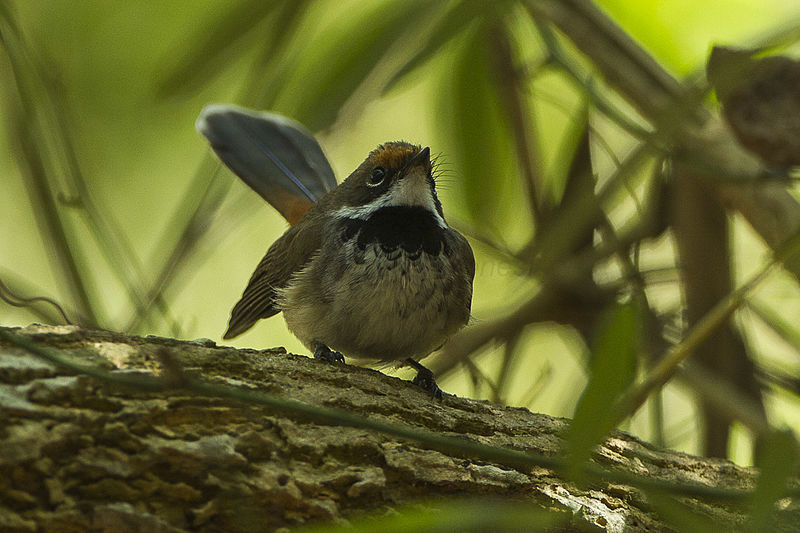
The Arafura fantail bird is native to the Lesser Sunda Islands, northern coast of Australia, and southern New Guinea. It is also known as the wood fantail.
Despite being similar to the rufous fantail bird, the Arafura fantail has been split taxonomically from it. The Arafura fantail is often found subcoastally in the Top End of the Northern Territory.
This bird is quite small and displays a beautiful plumage. In general, it is relatively easy to identify this bird species from its distinctive physical features. The Arafura fantail is an active bird that feeds mainly on insects.
Its habitat consists of tropical forests or other wooded environments. The conservation status of this bird is currently of least concern.Scientific classification:
| Kingdom | Animalia |
| Phylum | Chordata |
| Class | Aves |
| Order | Passeriformes |
| Family | Rhipiduridae |
| Genus | Rhipidura |
| Species | R. dryas |
43. Eastern Yellow Wagtail
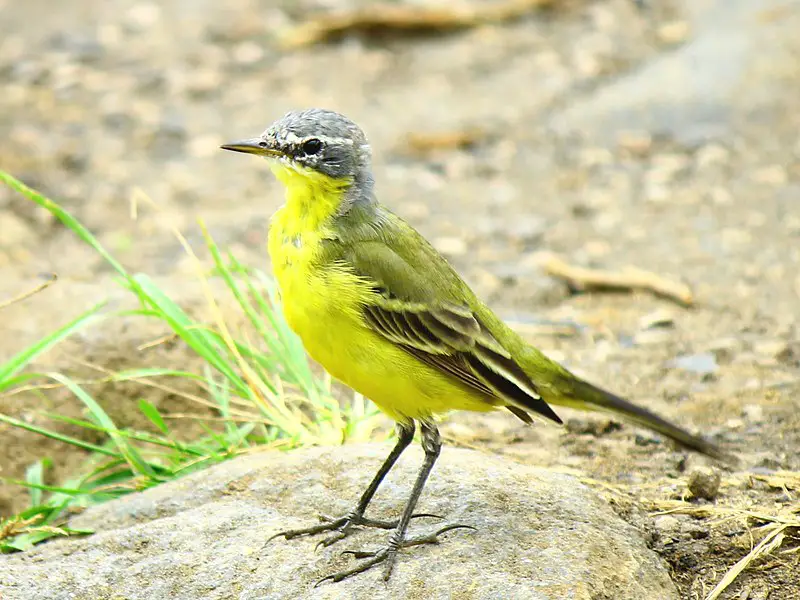
The Eastern yellow wagtail is a small passerine bird that belongs to the wagtail family. It was once classified as a subspecies of the Western yellow wagtail.
This bird species is found in the East Palearctic and breeds there, while it also has a foothold in North America in Alaska. During migration, these birds fly to South Asia and Australia.
Apart from their habitat, yellow wagtails are known for their distinctive yellow plumage that sets them apart from other birds. They are migratory birds, and some vagrant individuals are also found outside their usual range.
This bird has a unique personality and can be observed singing beautifully while hunting for insects. They are also known to rely mainly on open farmland and wet areas to survive.Scientific classification:
| Kingdom | Animalia |
| Phylum | Chordata |
| Class | Aves |
| Order | Passeriformes |
| Family | Motacillidae |
| Genus | Motacilla |
| Species | M. tschutschensis |
44. Red-Collared Lorikeet
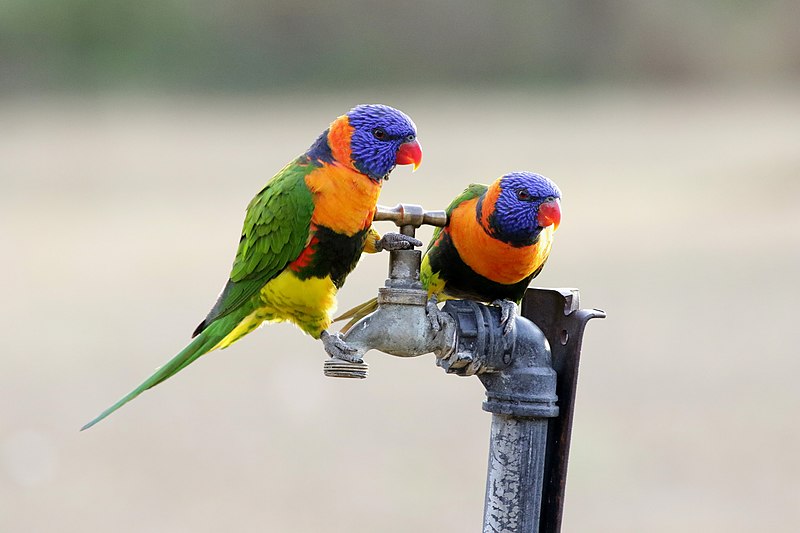
The Red-collared lorikeet is a unique species of parrot that inhabits wooded areas in the northern parts of Australia. Unlike its close relative, the rainbow lorikeet, this bird boasts a distinctive red collar around its neck, which gives it its name.
The Red-collared lorikeet was once thought to be a subspecies of the rainbow lorikeet, but today it is recognized as a separate species by most authoritative sources. It has a varied diet that includes nectar, pollen, fruit, and insects.
Male and female Red-collared lorikeets look very similar, but males tend to have larger heads and beaks than females.
These birds are known for their playful and sociable nature and are popular pets. However, the Red-collared lorikeet is a protected species in Australia due to habitat loss and illegal trapping for the pet trade.Scientific classification:
| Kingdom | Animalia |
| Phylum | Chordata |
| Class | Aves |
| Order | Psittaciformes |
| Family | Psittaculidae |
| Genus | Trichoglossus |
| Species | T. rubritorquis |
45. Yellow-Throated Miner
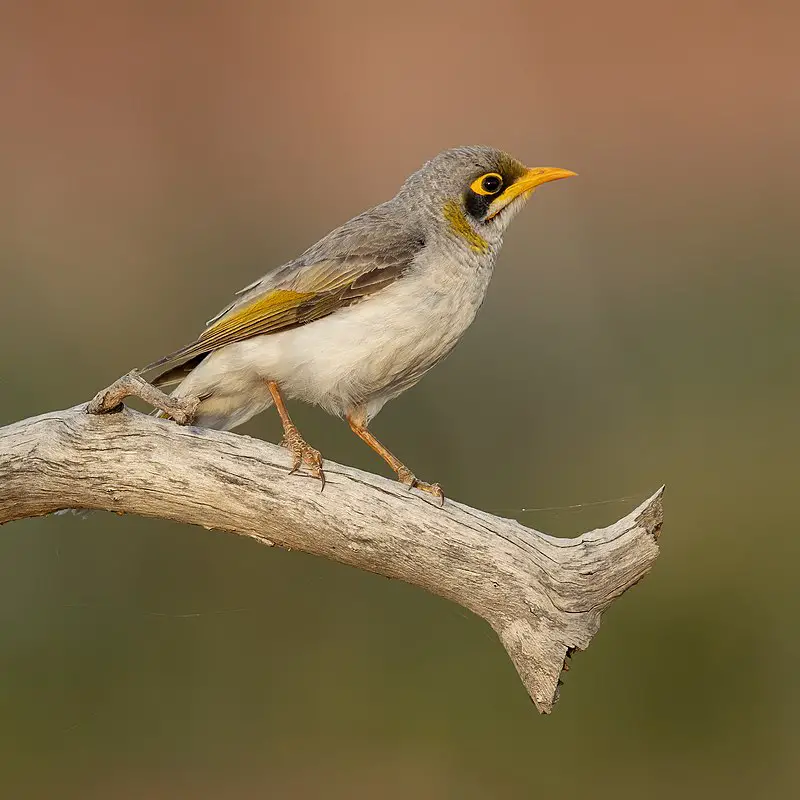
The Yellow-throated miner, or white-rumped miner, is a colonial honeyeater bird species found only in Australia. This medium-sized grey passerine bird has yellow markings on its throat, legs and bare patches around the eye.
Its distinctive white rump makes it easy to identify in the field compared to other miner species. The Yellow-throated miner is known to live in large communities and build its nests in trees, shrubs or low-lying plants.
This bird is an important pollinator and plays a key role in the ecological balance of its ecosystem.
Despite being common, the species is threatened by habitat loss due to urbanization and agriculture.
Conservation efforts are underway to protect the habitat of the Yellow-throated miner and ensure its survival for future generations.Scientific classification:
| Kingdom | Animalia |
| Phylum | Chordata |
| Class | Aves |
| Order | Passeriformes |
| Family | Meliphagidae |
| Genus | Manorina |
| Species | M. flavigula |
46. Eastern Grass Owl
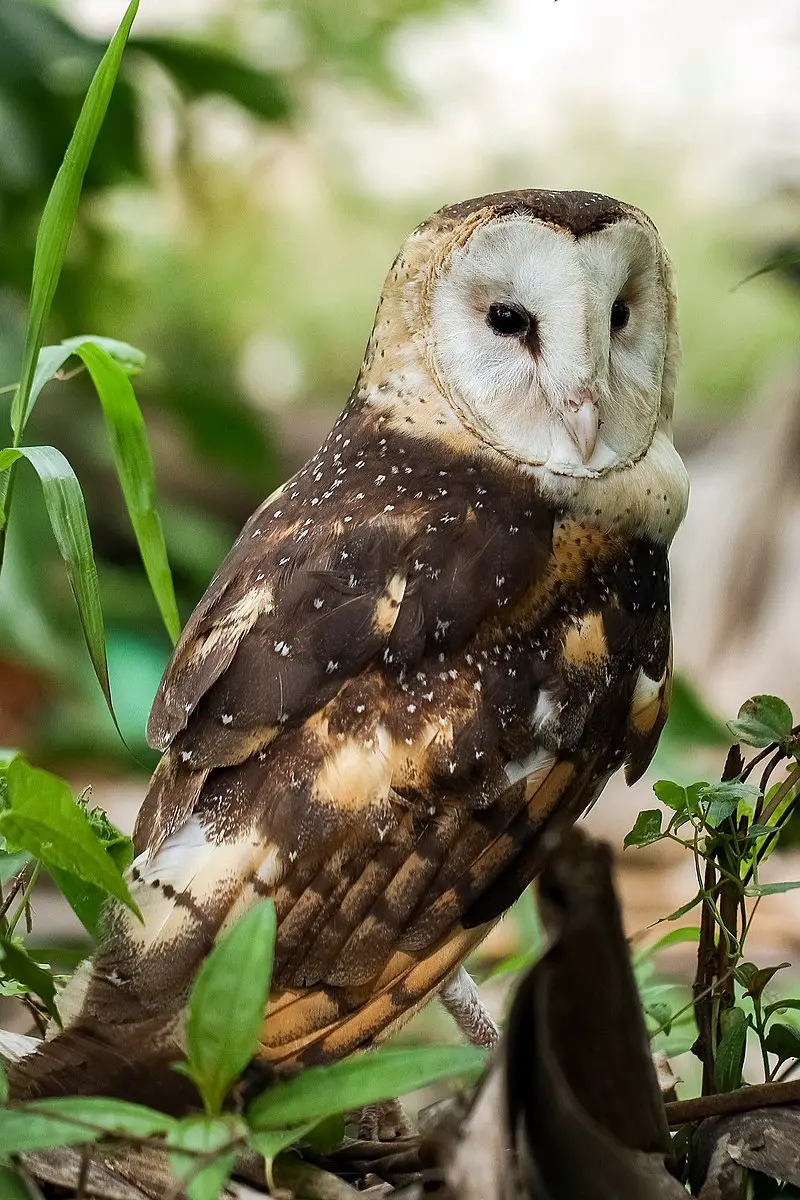
The Eastern grass owl is a medium-sized owl found in countries such as China and Australia. They mainly feed on small rodents.
Some experts believe that this owl is the same species as the African grass owl, while others view it as a distinct species.
It belongs to the Tytonidae family and is also known as the Chinese grass owl or Australian grass owl. The owl is similar in size to other medium-sized owls.
Overall, the Eastern grass owl is a fascinating bird species that continues to be researched and studied by ornithologists and other experts.Scientific classification:
| Kingdom | Animalia |
| Phylum | Chordata |
| Class | Aves |
| Order | Strigiformes |
| Family | Tytonidae |
| Genus | Tyto |
| Species | T. longimembris |
Also Featured In: Most Common Taiwan Birds, Birds of New Caledonia
47. Willie Wagtail
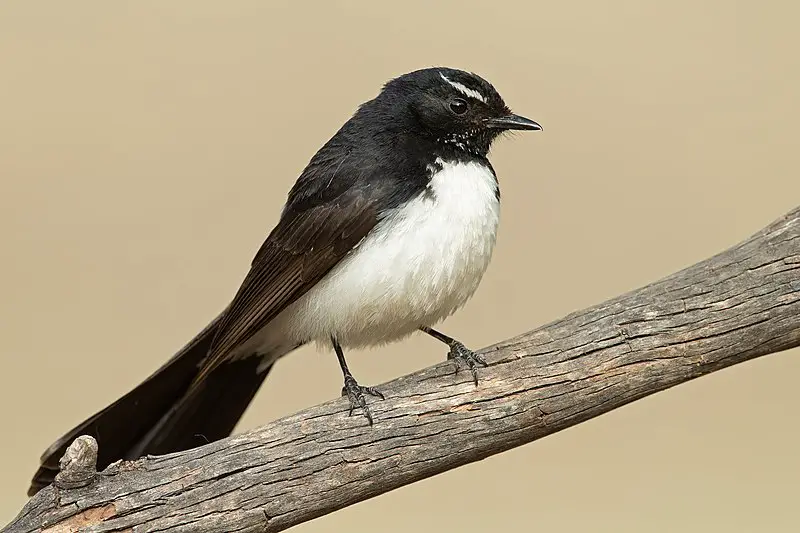
The Willie wagtail is a well-known bird in Australia, New Guinea, and other nearby regions. With its contrasting black and white plumage, this passerine bird stands out in most habitats, except for dense forests.
Its small size, measuring around 19- 21.5 cm in length, hints at its swift movements as it flies and dances through the air.
The Willie wagtail is a master of acrobatics and can quickly change direction while catching insects on the fly.
Its tendency to wag its tail up and down is how it got its name. This bird is a common sight in gardens, parks, and other open spaces, where it feeds on insects and small invertebrates.
Despite its size, the Willie wagtail is a bold and fearless bird and will attack much larger birds that threaten its territory.
Overall, this charming bird is a delight to observe in the wild.Scientific classification:
| Kingdom | Animalia |
| Phylum | Chordata |
| Class | Aves |
| Order | Passeriformes |
| Family | Rhipiduridae |
| Genus | Rhipidura |
| Species | R. leucophrys |
Also Featured In: South Australian Birds, Birds that You’ll find in Perth
48. Crimson Finch
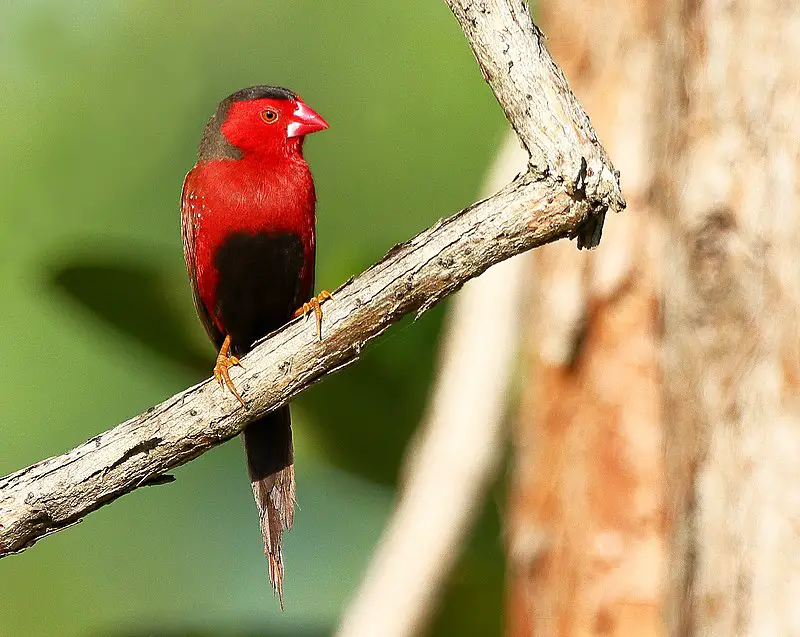
The Crimson Finch is a bold and striking bird belonging to the Estrildidae family. It can be found all throughout northern Australia and parts of southern New Guinea.
This bird is easily identifiable by its radiant crimson feathers, which makes it a very popular bird among birdwatchers. Despite its good looks, the Crimson Finch is known to be quite aggressive.
This makes it an interesting bird to observe but also one that should be approached with caution.
The Crimson Finch was first observed by Hombron and Jacquinot at Raffles Bay in northern Australia in 1841.
Its protonym is Fringilla phaeton. The Crimson Finch is a beautiful and fascinating bird that brightens up the Australian skies with its vivid plumage.Scientific classification:
| Kingdom | Animalia |
| Phylum | Chordata |
| Class | Aves |
| Order | Passeriformes |
| Family | Estrildidae |
| Genus | Neochmia |
| Species | N. phaeton |
Also Featured In: Spiritual Birds,
49. Shining Flycatcher
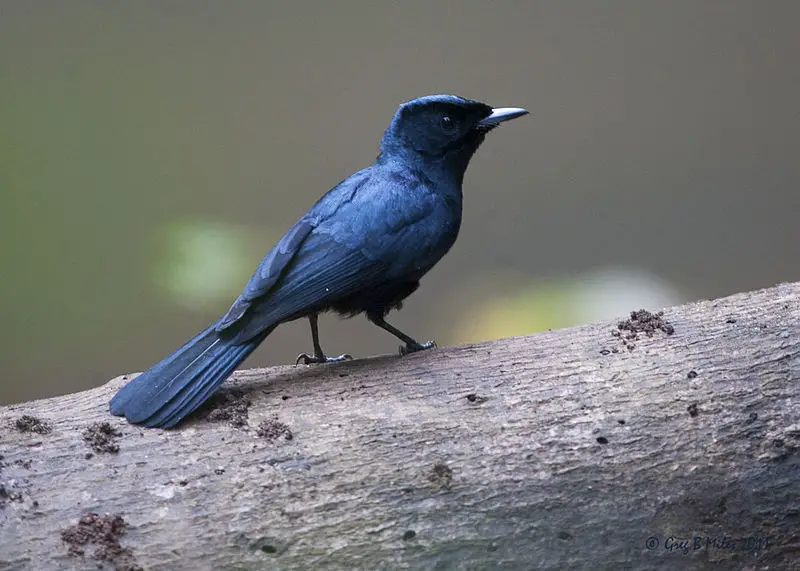
The Shining Flycatcher is a beautiful and slender bird with a long tail and fine bill. This species can be found in northern Australia, as well as in the Moluccas and the Bismarck Archipelago.
They typically inhabit subtropical or tropical moist lowland forests and mangrove forests. The male Shining Flycatcher is entirely glossy blue-black, while the female has a rich chestnut coloration above.
These birds are members of the Monarchidae family of songbirds.Scientific classification:
| Kingdom | Animalia |
| Phylum | Chordata |
| Class | Aves |
| Order | Passeriformes |
| Family | Monarchidae |
| Genus | Myiagra |
| Species | M. alecto |
Also Featured In: Birds that Live Near Halmahera, Waigeo Island Birds
50. Warbler-Finch
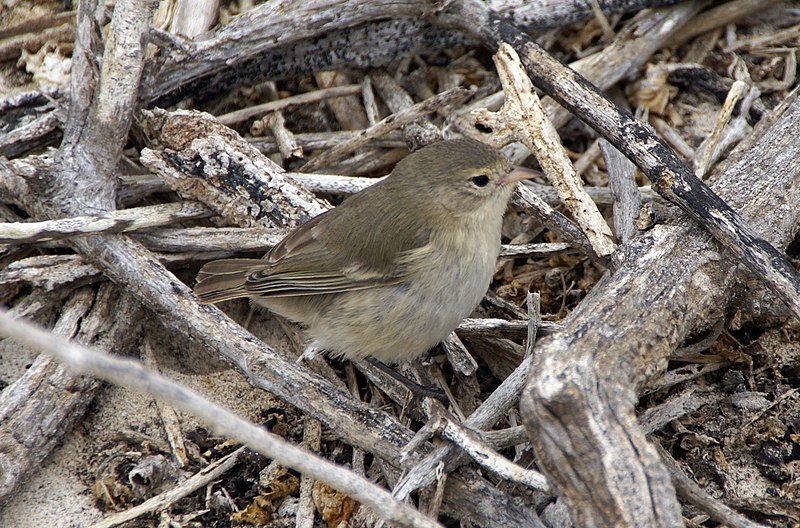
The Warbler-finches, also known as Darwin’s finches, are endemic birds of the Galápagos Islands in the tanager family Thraupidae. They belong to the genus Certhidea and comprise of two distinct species, which were previously considered conspecific.
These species differ in their songs, habitat preferences, and distribution on the islands. The Warbler-finches are famous for their significant role in Charles Darwin’s theory of evolution.
They played a crucial part in establishing the concept of adaptive radiation as Darwin observed their beak variations to adapt to the different food sources available on the islands.
These charming bird species have orange and yellow plumage and can be seen flitting through the foliage in search of insects, berries, and flowers.Scientific classification:
| Kingdom | Animalia |
| Phylum | Chordata |
| Class | Aves |
| Order | Passeriformes |
| Family | Thraupidae |
| Genus | Certhidea Gould, 1837 |
51. Royal Spoonbill

The royal spoonbill is a large bird found in wetlands across Australia, New Zealand, Papua New Guinea, and the Solomon Islands. Known for its distinctive spoon-shaped bill, it feeds on small fish, crustaceans, and insects in intertidal flats and shallow waters.
This black-billed spoonbill is also sometimes sighted as a vagrant in New Caledonia. In New Zealand, it is called kōtuku ngutupapa by the Māori people.
The royal spoonbill is often seen wading through water with its head bobbing back and forth as it searches for prey.
Its striking all-white plumage and bright yellow crest make it a popular sight for birdwatchers and nature enthusiasts.
The royal spoonbill is a fascinating bird, perfectly adapted to its aquatic habitat and always a delight to see in the wild.Scientific classification:
| Kingdom | Animalia |
| Phylum | Chordata |
| Class | Aves |
| Order | Pelecaniformes |
| Family | Threskiornithidae |
| Genus | Platalea |
| Species | P. regia |